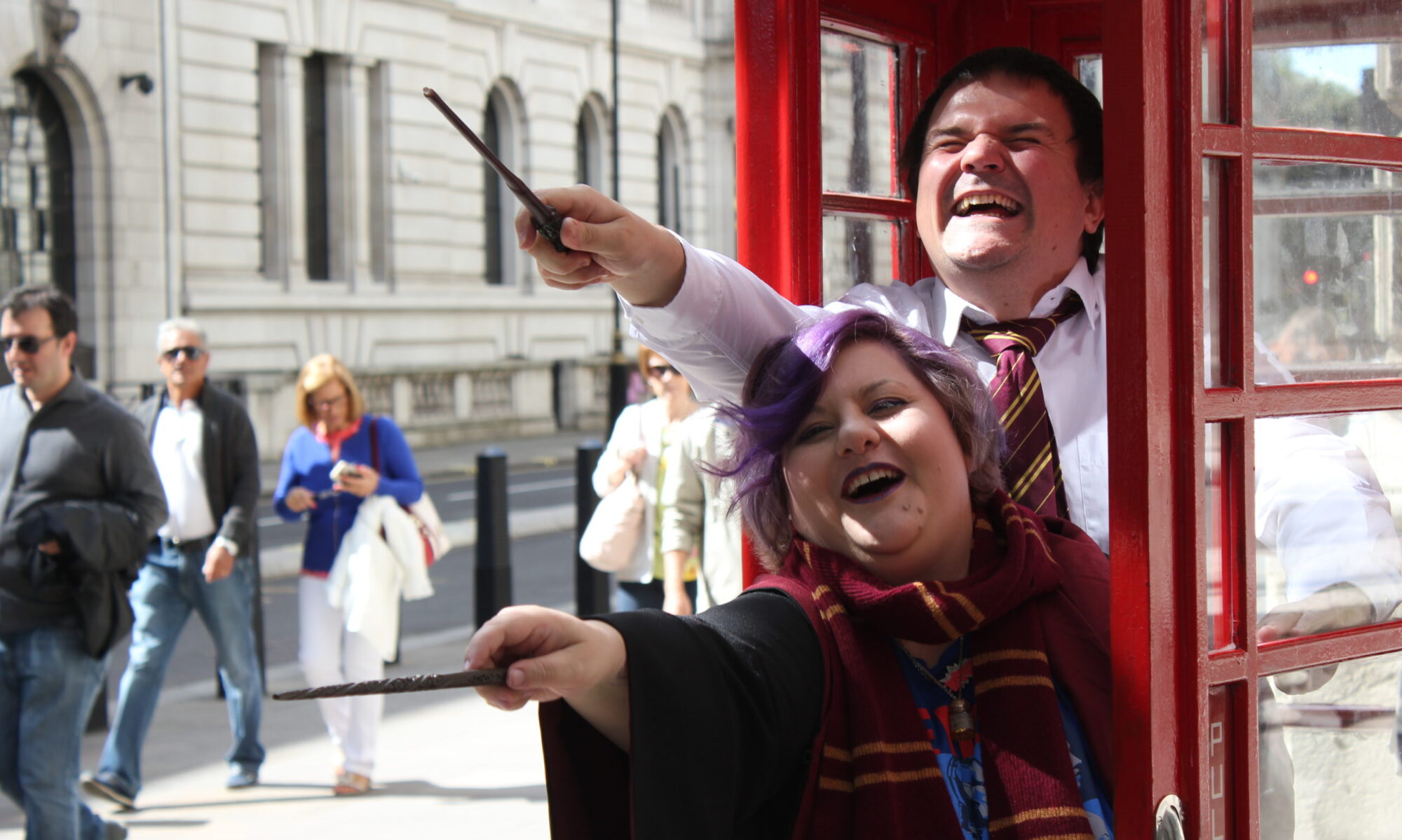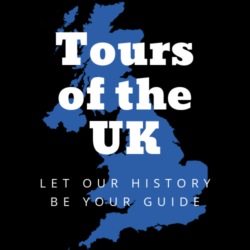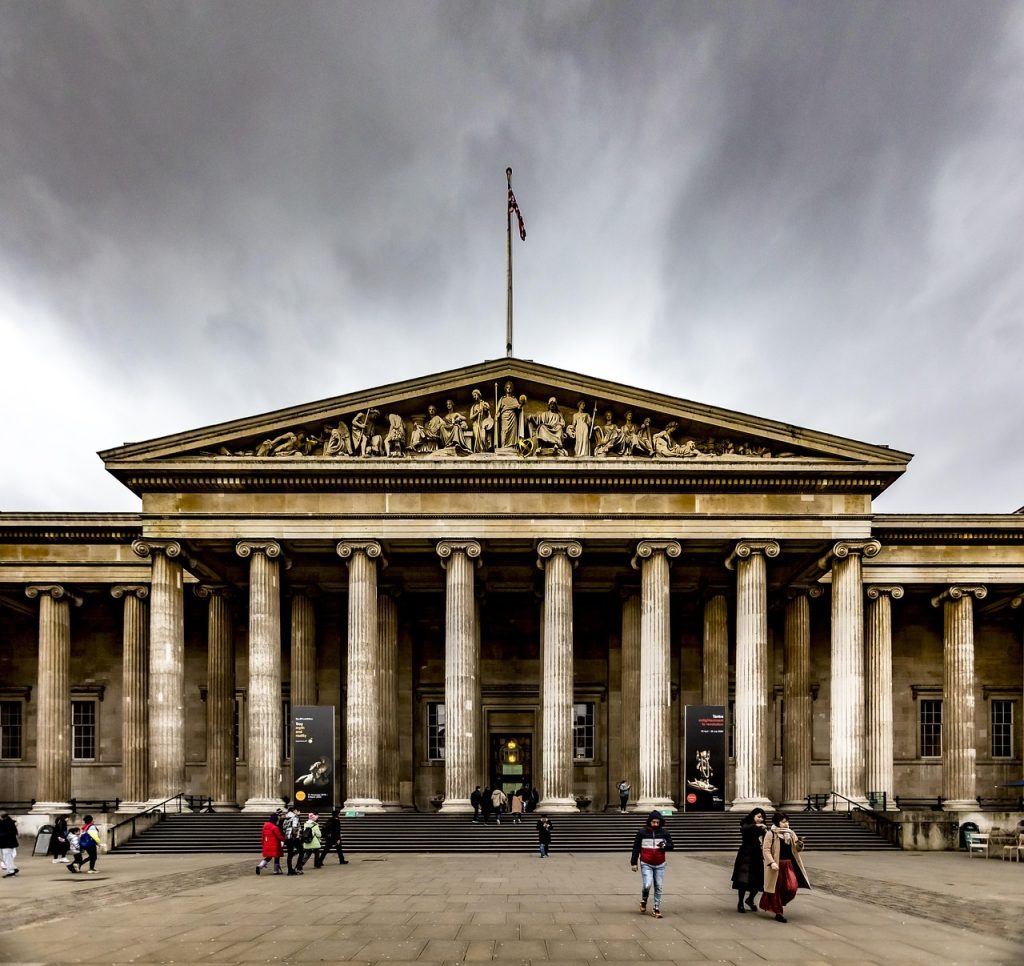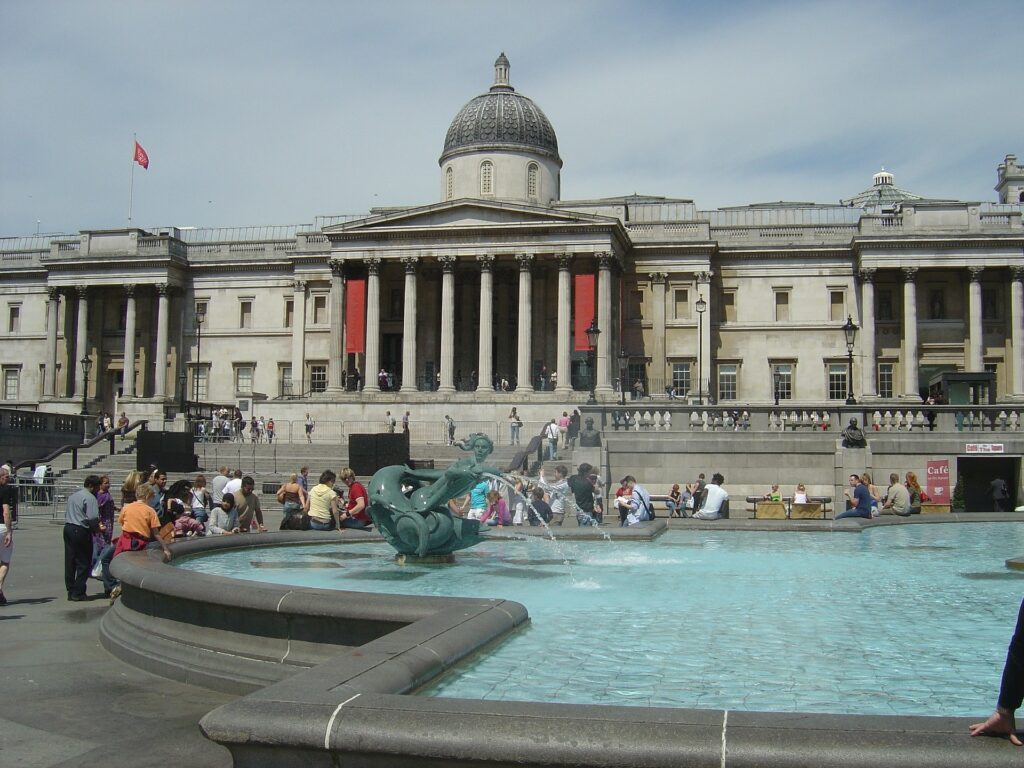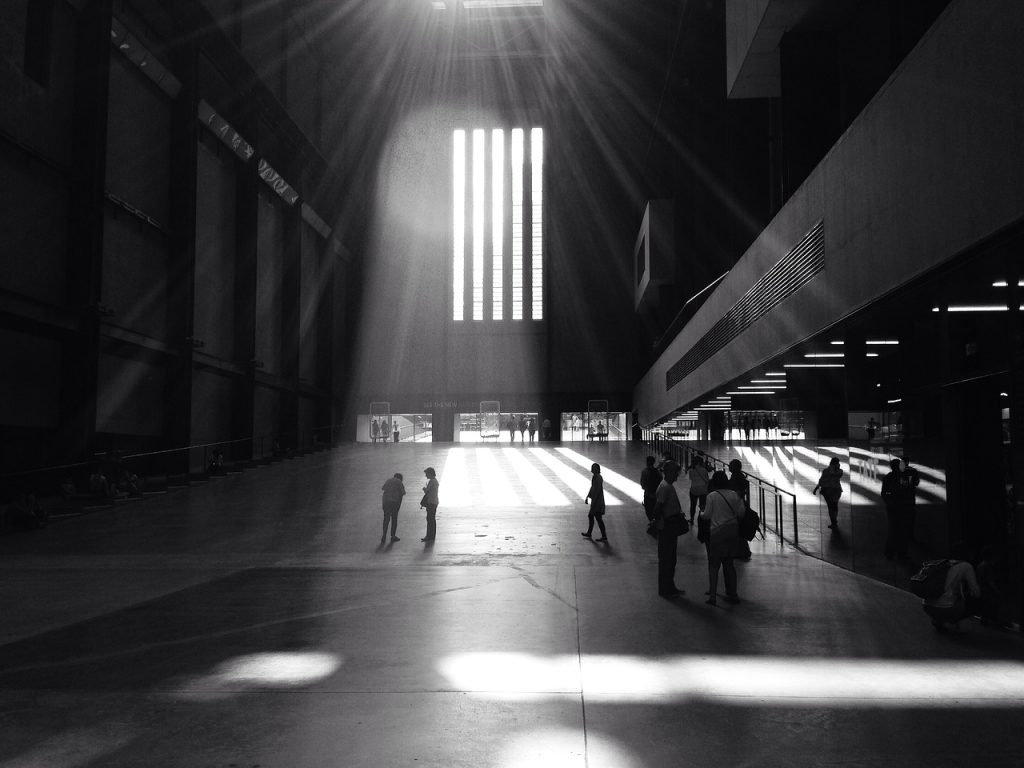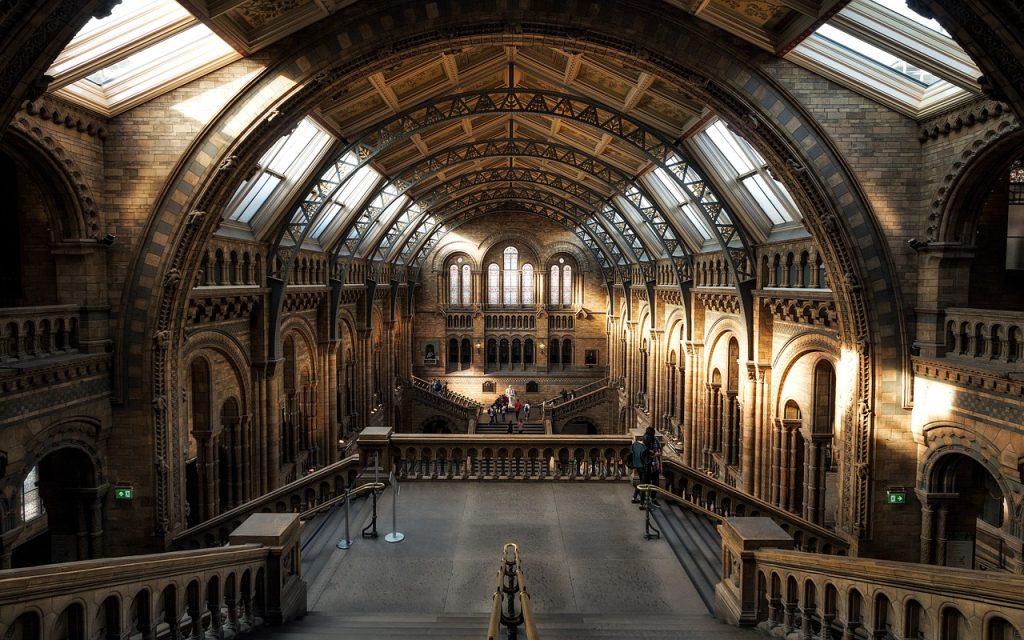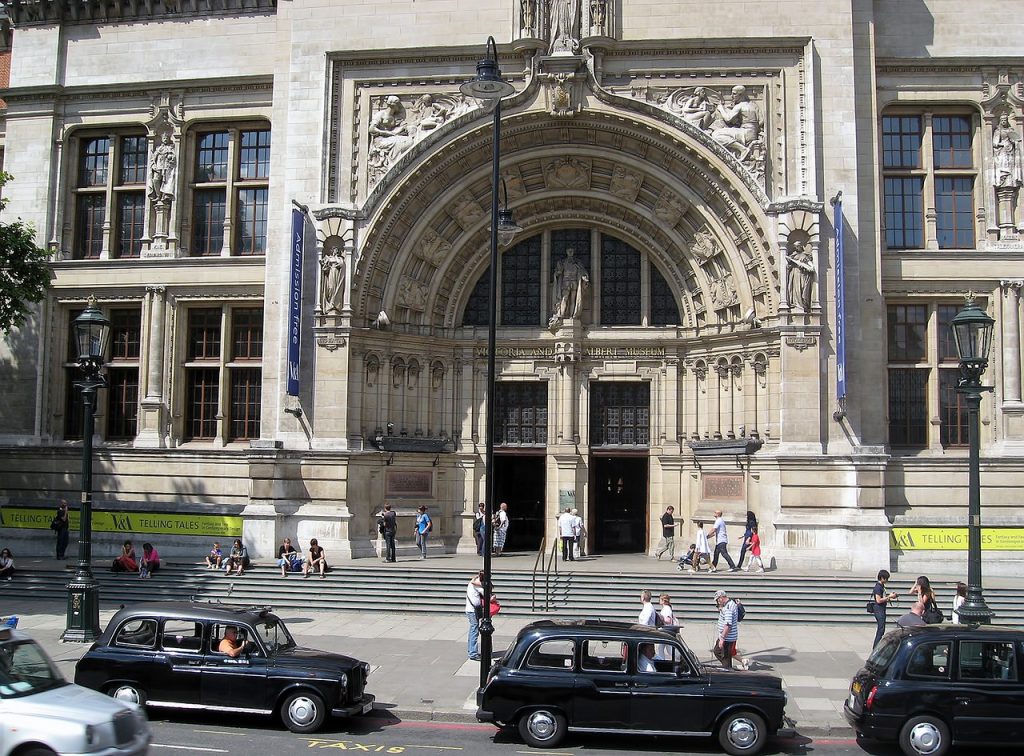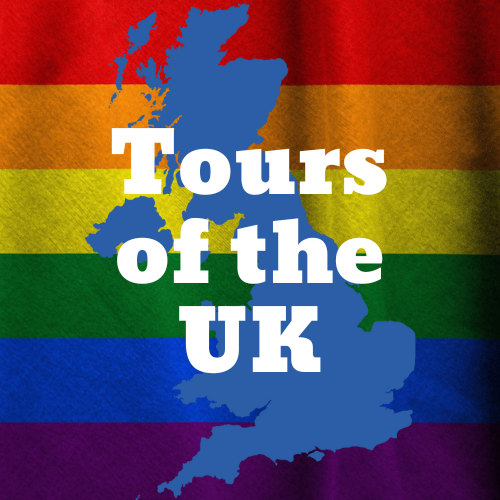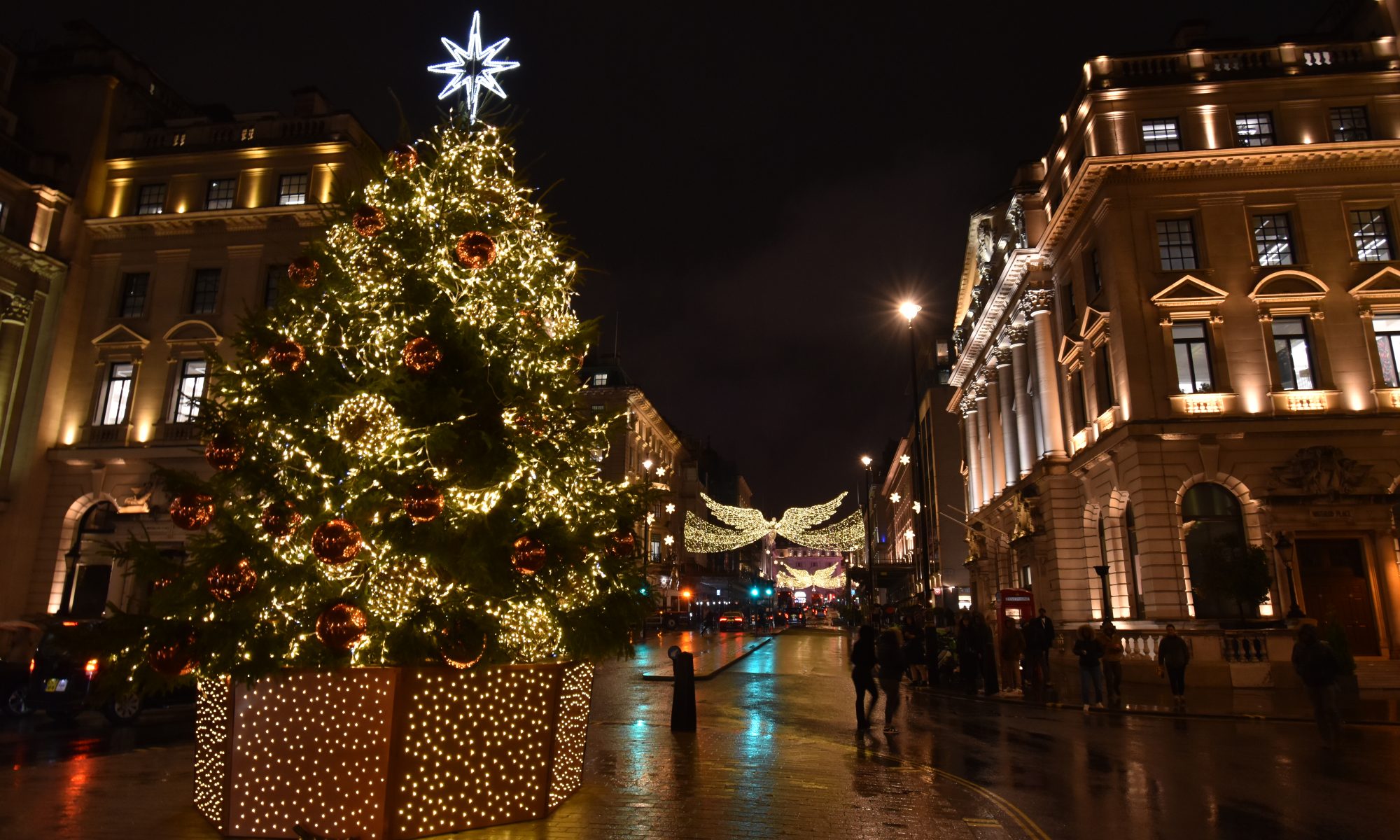LGBT History Month 2025 – The Ladies of Llangollen By Dr Emily Garside
To celebrate LGBT History Month here in the UK, we’ve asked the wonderful Queer academic Dr. Emily Garside, to create a weekly blog throughout February celebrating the fantastic LGBTQIA+ people and places of Britain.
This week Emily focuses on the Ladies of Llangollen, two iconic historical Queer figures who lived in North Wales and whose home is still a well-loved visitor attraction.
The Ladies of Llangollen
The “Ladies of Llangollen” are probably Wales’ best-known historic queer figures. And after Anne ‘Gentleman Jack’ Lister (who they met), probably the most famous queer woman of their era.
The ladies were two upper-class Irish women, Eleanor Butler (1739–1829) and Sarah Ponsonby (1755–1831), who moved from Ireland to Llangollen, North Wales, in 1780 to live together and escape the pressure to undertake a traditional marriage. They arrived in 1780 at their home, Plas Newydd in North Wales, where their relationship would both fascinate and scandalise.
Growing up, they lived about 15 miles from one another at home in Ireland. They first met in 1768 and became close quickly. They began to develop a dream to live a rural life together somewhere they would be undisturbed. A pressing matter for ladies of their class who would usually be married off to a suitable gentleman when they ‘came of age’, they could circumvent this and get their wish by escaping together.
So, when they were of age, rather than be married to a suitable noble gentleman to further family finances and politics, and indeed to secure their future, they rejected unwanted marriages and left Kilkenny together in April 1778. Their families tried to force them to give up their plans and return, but ultimately, their efforts were in vain.
After leaving home, they rented a cottage, but in 1780, they moved to Plas Newydd (which translates to ‘new mansion’). They worked on the house over the years, installing oak panelling and stained glass to make it into the ‘Gothic’ style, which it remained for much of their time there. They added a dairy and curated an extensive and impressive garden.
They were known for accepting visitors as both friends and curious visitors, receiving them in the extensive library they created. These guests included royalty in the form of Queen Charlotte. The Queen was so enamoured with the ladies that she compelled her husband, King George III, to provide them with a pension. As well as royalty, they received nobility, such as the Duke of Wellington, perhaps silencing the notion that as unconventional and queer women they were entirely shunned.
They also spent time studying language and literature. Many creatives were also among their visitors, compelled by the Ladies’ alternative lifestyle and devotion to literature and learning. These included writers such as Anna Seward, Robert Southey, William Wordsworth, and Percy Shelley. Perhaps the most notable visitor was not Royalty but Lesbian Royalty in the form of Anne Lister. While it isn’t certain, the timelines overlap with Anne’s marriage to her lover (Ann Walker). The Ladies and their chosen lifestyle somewhat inspired her (and potentially her them). For Lister and the ladies, there was no doubt of solidarity in their arrangements.
The Ladies were also known for eccentricity, including their dress. They would wear black riding habits and men’s top hats. However, this was also seen as practical attire for two women who needed to work the land and be outdoors as their lifestyle dictated. Again, we see similarities with Anne Lister, who was known for her ‘masculine’ attire, and perhaps, between them, some forerunners for a particular brand of lesbian fashion.
Despite their eccentricities and not conforming to standard ways of living, their community accepted them and became part of the local community in Llangollen. Eleanor recorded all these elements in her diary, which were also assimilated into the community. Llangollen people referred to them as “the ladies”, and they became part of the community. After settling in, they soon became both a stop-off for visitors between Ireland and London and something of a curiosity for many – which they embraced.
The Ladies lived fifty years together and died within a year of each other: Elenor in 1829, at age 90 and Sarah in 1831, aged 76. They and are buried at St Collen’s Church, Llangollen.
The legacy of the ladies lives on in literature and more, and perhaps inspires some of their literary or creative visitors. During their own time, William Wordsworth wrote a sonnet about them. They were called “To the Lady E.B and the Hon. Miss P”. Anna Seward wrote the poem “Llangollen Vale” in 1796, associating them with “chaste provinciality”. A little later, the ladies appeared in a “thinly veiled biographical novel” called Chase of the Wild Goose by Mary Gordon in 1936. The book was later reprinted and retitled The Llangollen Ladies: The Story of Lady Eleanor Butler and Miss Sarah Ponsonby, Known as the Ladies of Llangollen, in a nod to the story’s origins. Up to today, intrigue in their story continues, with a 2022 theatrical production at Theatr Clwyd in their beloved north Wales. The play ‘Celebrated Virgins: The Story of the Ladies of Llangollen’ by Katie Elin Salt introduced their story to new audiences via theatrical telling. And with renewed interest in their friend Anne Lister through the series Gentleman Jack, perhaps the story of the Ladies will get more incarnations in the future…
Their legacy has certainly lived on; their house Plas Newydd is now a museum and popular wedding venue (for mainly queer couples, naturally). The surrounding area continues their legacy with Butler’s Hill, near Plas Newydd and The Ponsonby Arms on Mill Street in Llangollen, both honouring the women, respectively.
Find out more about visiting Plas Newydd here
LGBT History Month 2025 – Queer British Icons by Dr Emily Garside
To celebrate LGBT History Month here in the UK, we’ve asked the wonderful Queer academic Dr. Emily Garside, to create a weekly blog throughout February celebrating the fantastic LGBTQIA+ people and places of Britain.
This week Emily focuses on Queer Icons of British History as the UK has a long, rich history of Queer folks making an impact and making history. This list mixes up those Queer icons you might have heard of with a few who might be new to you. To celebrate the well-known but often overlooked contributors to LGBTQ+ history in the UK.
Miriam Margolyes
This absolute national treasure is known for her acting roles across multiple generations. She won a BAFTA Award in the ’90s for her appearance in The Age of Innocence and has also appeared in Blackadder, Baz Luhrmann’s Romeo + Juliet and last year, she had a cameo in Call The Midwife. She became an Australian citizen back in 2013, admitting: “I fell in love with an Australian woman, in case anyone didn’t know I was a dyke, and I’m very happy and we’ve been together since 1968.”
Ivor Novello
Ivor Novello, originally named David Ivor Davies, was born in 1893 on Cowbridge Road East in Cardiff, Wales. He was an actor, singer, composer, and one of the most influential entertainers of the 20th Century. His work is still prevalent in the 21st Century. Despite being one of the queer community’s “hidden” queer people given the era he lived in, he did manage to live quietly ‘out’ within the theatre community with his partner of 35 years, Bobbie Andrews, and reportedly many other lovers as well. It was also widely speculated in fan magazines during his lifetime around his sexuality, yet still, he was hugely successful. Showing perhaps the safety of the theatre industry for queer folks and the ability to live a secret but also open life enjoyed by many of his era in the industry. Alongside all this, he is also one of Britain’s best-loved songwriters of the 20th Century.
Radclyffe Hall
More than merely influential, the author Radclyffe Hall arguably did more than any other person to make Western society acknowledge the reality of same-sex love and attraction between women. Her 1928 novel The Well of Loneliness chronicled the life and romances of Stephen Gordon, a woman who accepts that she’s a lesbian and proceeds accordingly despite society’s mores and restrictions.
Ending with the words ‘Give us also the right to our existence’, the book was expressly written to establish lesbianism as a fact of life. Still, scandalised critics who warned of its ‘depravity’ and ‘moral danger’ Despite being banned, the book became a totemic inspiration to many who’d been afraid to express their sexuality. ‘It has made me want to live and to go on,’ one grateful reader wrote to Radclyffe Hall, while another thanked her for expressing ‘many of the terrors’ of living in a time of oppressive homophobia.
Kenneth Williams
Williams is best known for his role in the British comedy film series ‘Carry On,’ produced from 1958 to 1978. The series made several famous British actors, including Barbara Windsor, famous. The films are filled with signature double entendres and politically incorrect humour (even for that time) and are the epitome of the British camp. Williams was a queer actor who played a camp character in the films and was able to “play gay” for all intents and purposes and be at the centre of the movie. Williams’ character was queer-coded in a mainstream film, loved by all sorts of audiences, including straight ones.
His sexuality has, to some degree, been conflated with his on-screen persona, and it assumed he was a gay man. He was certainly part of the ‘gay scene’ at the time, being friends with playwright Joe Orton and part of the arty, London queer set. It was, as they say, a different time, and how Williams chose to interact with the Queer community perhaps reflects that. Possibly, too, it was because the conversation around how Williams identified wasn’t- and indeed isn’t still- a common one. Williams frequently identified as Asexual in interviews, talking about being celibate. While this was often rebuked as a way for him to hide his ‘homosexual identity’ from his diaries, it seems accurate (and also, who is anyone to refute what anyone claims as their identity). Williams lived alone all his adult life and had no significant relationships.
Jan Morris
A successful journalism career for mainstream newspapers like The Times or The Guardian. This meant to reporting on many of the high-profile political and world events of the following decades. This included the Suez Crisis for the Guardian, which, along with Everest, was one of her most famous pieces of journalistic work and firmly cemented her as a leader of investigative journalism. Later she became known for documenting her transition, one of the first high-profile transwomen to do so. Morris was faced with a conundrum upon her transition- either do so in relative secrecy to avoid scrutiny and probable transphobia, but also, in the process, potentially lose the journalistic reputation she’d built up to this point. So instead, she leaned into what she had and wrote about it, publishing a book, Conundrum, in 1974, which documented her transition. It was hugely important in both lifting the lid on what went on during the gender transition but also in Morris keeping ownership of her identity and her career. She continued a hugely successful journalism and travel writing career. She had been married pre-transition and remained with her wife. They eventually divorced so they could re-marry as a same-sex couple when that became legal.
Lady Phyll
Phyll Opoku-Gyimah, commonly known as Lady Phyll, is a British activist who advocates for LGBT rights and anti-racism. She co-founded UK Black Pride, which began in 2005 as a day trip to Southend-on-Sea, England. The event has grown significantly and now attracts nearly 8,000 participants each year.
Lady Phyll established this event to foster unity and cooperation among LGBT individuals of African, Asian, Caribbean, Middle Eastern, and Latin American descent in the UK and their friends and families. Additionally, she serves as the Executive Director of the Kaleidoscope Trust, a charity that advocates for the human rights of LGBT people in countries where they face discrimination.
There are, of course, an array of icons- famous and not- who make LGBTQ+ history daily in the UK. We should also celebrate our community heroes along with famous people. But this LGBTQ+ history month, we should honour those who have impacted our history as a nation and as a community.
Alan Turing
Alan Turing, made internationally famous by the biopic The Imitation Game, is revered for his crucial role in breaking German cyphers during World War II. His work at Bletchley Park is believed to have shortened the war by at least two years. However, this was just one of many significant contributions he made to science, society, and culture throughout his life. In the 1930s, he invented the theoretical “Turing machine,” which became a foundational concept in computer science. Turing also made advancements in artificial intelligence and theoretical biology.
Tragically, his career was cut short when he was convicted of homosexual acts, which were illegal at the time. This resulted in his being subjected to chemical castration. Turing’s death from cyanide poisoning in 1954 is widely regarded as a suicide.
In 2013, he was pardoned for his crime, and in 2017, the government officially agreed to pardon men accused of similar crimes, meaning they would no longer have a criminal record. This pardoning is known as the Alan Turing Law. In 2019, Turing was named the most “iconic” figure of the 20th Century, and his image now appears on the £50 note.
A copy of this £50 note and the pardon issued to him is housed, along with some of Turning’s personal effects, at Bletchley Park where Turing worked. Bletchley Park has also carefully recreated Turing’s office, where he worked on the Turning Welchman Bombe, as well as other ways of breaking the infamous Enigma code. Want to visit Bletchley Park? Why not take our Tour.
Suzy Izzard
Initially known for her stand-up comedy, Suzy Izzard has become a charity campaigner, anti-Brexit advocate and Trans icon. She began as part of the alternative comedy scene in the 90s. She quickly skyrocketed to selling out arenas and becoming one of the decade’s most influential and successful stand-ups. She was known for irreverent humour, at that point referring to herself as a ‘transvestite’ for her well-known feminine-coded outfits on stage. She would later further lean into her trans identity in later life, and in 2023, asked to be known as Suzy and used She/Her pronouns. She’s had a hugely successful acting career alongside her stand-up, including roles in Hannibal and Ocean’s Twelve. But she also has never shied away from politics, being outspoken against Brexit and, in 2022, ran for MP in Sheffield. She wasn’t elected but continues to be active in the Labour Party and outspoken for Trans rights.
Allan Horsfall
In recent years, he has often been referred to as the grandfather of the gay rights movement for openly advocating as a gay man during a time when homosexuality was still illegal.
In 1964, Allan Horsfall and a group of friends founded the North West Homosexual Law Reform Committee, even using his home address as the organisation’s base. Being so openly involved at that time took considerable bravery. This committee became the first campaigning organisation outside of London set up and run by gay men, and its efforts directly contributed to the decriminalisation of homosexuality.
Eventually, the North West Committee evolved into the Campaign for Homosexual Equality (CHE), the largest LGBT organisation in the UK, boasting over 5,000 members and 120 local groups at its peak. His work in removing the stigma of criminality surrounding homosexuality remains one of his most significant achievements.
Virginia Woolf
She’s known for writing Mrs Dalloway, To The Lighthouse and A Room of One’s Own. She had close relationships with women, including English poet, novelist and garden designer Vita Sackville-West, who inspired Virginia’s novel Orlando.
Virginia Woolf was one of the key figures in Modernism, her dreamy, stream-of-consciousness prose helping transform literature in the 20th Century. Along with writing classics like To the Lighthouse and Mrs Dalloway, she penned the key feminist text A Room of One’s Own. Her personal life was also boundary-breaking – she had a now-famous affair with fellow writer Vita Sackville-West. Their letters convey the turbulent passion of the romance, with Virginia once writing to Vita, ‘Yes yes yes I do like you. I am afraid to write the stronger word’.
Vita Sackville-West inspired Woolf’s novel Orlando, whose hero magically changes sex and lives for centuries. It’s one of the first great tales of gender fluidity in the English canon, inspiring generations of writers and artists such as cartoonist Alison Bechdel, author of the landmark Dykes to Watch Out For comic strip, who mused ‘it’s hard to fathom how Virginia could play so freely with sexual identity in that much more conservative era.’
Mark Ashton
Despite being the subject of the beloved 2014 film Pride, Mark Ashton often goes unnoticed, even though he significantly influenced the course of gay rights in the UK. Ashton founded the activist group Lesbians and Gays Support the Miners (LGSM) after he and his friend Mike Jackson collected donations for striking miners during the 1984 Pride march in London. This organisation formed an alliance that supported the National Union of Mineworkers as they battled against mine closures under Margaret Thatcher’s government. This also meant the first shift to Labour supporting Gay Rights as part of their policies (With the support of NUM who were one of the most influential unions at this point). The impact of LGSM in terms of support of the miner’s strike and future policies around LGBTQ+ rights was huge. Ashton didn’t live to see all of it come to fruition, as he died of AIDS-related illness in 1987.
Sandi Toksvig
A comedian, TV presenter and author became one of the first celebrities to come out as a lesbian. She said that having three young children made her decide to come out because there were no out lesbians in British public life, and she didn’t want her children to grow up ashamed of having two mothers. She was warned she might never work again, and the family faced death threats, going into hiding for some time. Sandi has had an impressive career and is presenting QI and The Great British Bake Off.
Anne Lister
Anne Lister was an English diarist known for her groundbreaking revelations, earning her the title of “the first modern lesbian.” She had several lesbian love affairs, which began during her school days and continued throughout her life, often while travelling extensively abroad. With her muscular and androgynous appearance, Lister was typically dressed in black and was highly educated. She was later nicknamed, sometimes unkindly, “Gentleman Jack.”
Her most significant relationship was with Ann Walker, whom she notionally married at Holy Trinity Church in Goodramgate, York. This event is now celebrated as a landmark moment in the history of lesbian marriage in Britain.
Lister’s diaries provide valuable insights into contemporary life in West Yorkshire. They detail her development of Shibden Hall and her interests in various fields, including medicine, mathematics, landscaping, mining, railways, and canals. Her entries were written in code, which remained undeciphered long after her death. Her diaries, which contain explicit depictions of lesbian relationships, were so candid that they were initially considered a hoax until their authenticity was later confirmed.
Justin Fashanu
Justin Fashanu was Britain’s first openly gay footballer, and even after 30 years, he remains the only male footballer to have revealed his sexuality while playing professionally in the top tiers of the sport.
His career was promising; he rose through Norwich City’s youth ranks and, in 1981, became the country’s most expensive black player with his £1 million move to Nottingham Forest.
In 1990, he shocked the football world by announcing his sexuality in a newspaper interview. However, after this revelation, he faced a significant lack of support, enduring homophobic bullying and harassment from tabloid newspapers.
Fashanu passed away in 1998, and in February 2020, he was inducted into the National Football Museum’s Hall of Fame. His niece, Amal Fashanu, called him “one of the bravest men I’ve ever come across.”
Carol Ann Duffy
Became the first female LGBTQ+ Scottish poet to be a Poet Laureate. She held the position until 2019. This made her the first woman to hold the title, the first Scottish poet, and the first openly gay or bisexual person to do so. Her work has been studied extensively in British schools, and some of her most famous collections include the Whitbread Poetry Award-winning Mean Time and the T.S. Eliot Prize-winning Rapture. She has previously had long-term relationships with fellow poets Adrian Henri and Jackie Kay. She’s published dozens of poetry collections and is studied by many GCSE and A Level students.
Gareth Thomas
Iconic rugby player and, in later years, iconic Panto star Gareth Thomas made history by coming out as gay during his international Rugby career –the first player to do so. Significant for both his contribution as a rugby player and his commitment to activism for both LGBTQ+ issues and HIV awareness, he’s made a substantial impact on both the sporting world and queer representation.
He holds the Welsh record for most tries in a game (against Italy in 1999) and, until 2011, was the most capped player in Welsh rugby. He still jointly holds the record for most Rugby World Cup appearances (along with other Welsh players Jenkins and Alun Wyn Jones). He played 100 test matches and retired in 2011. Many more accolades associated with his rugby career could be listed, demonstrating his impact on the sport.
Ten years after coming out as gay, Thomas has also revealed he is HIV positive. His disclosing his HIV status was hugely influential; the condition is still hugely stigmatised both within the LGBTQ+ community and outside it. Thomas, who is a healthy athlete who is both living everyday life and able to perform his sport at an elite level, goes a long way in breaking the stigma and assumptions that some people still have about HIV and in shifting the narrative around gay men in the sport.
Jess Fishlock
Another footballer, Jess Fishlock, has had a hugely successful club and international career while advocating for LGBTQ+ rights and women’s sports. Born in Cardiff, Fishlock is one of six siblings and began playing football with her sister before joining the Cardiff City Ladies F.C. at age 9.
Across her career, Jess Fishlock has been open about her sexuality and vocal about the need to support queer athletes and have stronger stances against homophobia in sports. On joining her American team in Seattle, Fishlock began working closely with Athlete Ally, an American non-profit organisation that works to erase homophobia and transphobia in sports.
The Tradition of Christmas Lights and Window Displays in London By Dr Emily Garside.
Christmas decorating traditions go back a long way- the Victorians introduced Christmas trees, with Prince Albert- husband of Queen Victoria- often credited with bringing the tradition over. But in actuality, Queen Charlotte, the German wife of Goerge III, brought the first Christmas tree to Windsor in December 1800. But it was Albert and Victoria who helped to popularise the tradition. In 1840, Albert imported several fir spruces from his native Coburg in Germany to use as future Christmas trees. A few years later, thanks to popular magazines like Illustrated London News picking up on the Royal tradition and writing about it, they began to be popularised with the upper classes, who wanted to ‘keep up with’ the Royals, and eventually filtered down to more everyday households. However, lights as Christmas decor at home and in public didn’t become popular until the 1920s, when people began to have electricity in their homes. From this, the popular ‘fairy lights’ that have become part of the Christmas tradition became popular, with people lighting up their homes in colourful lights to celebrate the season. Houses around this time began to look like the ‘Christmas decorations’ we are familiar with today.
We’re used to the array of shops decorating for Christmas now, but Selfridges in London was the first place to do that. In 1935, they decorated not just with a traditional Christmas tree but themed windows and lights that spanned the length of the store. These have evolved over the years and are often sponsored by different brands, making them more advertisements than simple festive cheer. However, the store also employs artists and designers to create attractive window displays alongside festive decorations across London.
Some previous years' Christmas Window Displays.
A little while later, in the 1950s, Regents Street joined the Festive decorating tradition. It began through the Regent Street Association- a group representing the shop owners of the street and taking responsibility for upkeep and other elements of the iconic street. So in 1954, festive lights- a more simplistic set of string lights- went up and down the street for the festive season.
They wanted to make Christmas feel a little less drab and sad after World War Two’s end, but this was the first Christmas with no rationing since 1940. Introduced in 1940, rationing restricted how much each person could buy during the Second World War to ensure minimal food and material shortages (and to divert resources to the war effort). Rationing continued for almost a decade after the war, so shops were affected. It finally ended in 1954, allowing many shop owners to flourish again. But of course, people weren’t used to shopping for ‘fun’ in the way we think of it now, so the idea of a light display to entice people out and into the shops was born.
Across the 1950s and into the 1960s, the idea spread to nearby Oxford Street, and the biggest array of lights in London that we know today was born. However, the light displays ran into some troubles in the 1970s, with economic pressures on both the business owners who contributed and the local council supporting them, and they ran into financial difficulties. In one quirky response, gas-filled balloons replaced the traditional lights on Regents Street.
The Christmas lights began again in 1978 with laser lights pointing up and down the street, which was an unusual choice, possibly inspired by the box office smash Star Wars that was released the year before. However, the Christmas Lights in London reverted to what was traditionally used the following year. With the support of the local traders’ associations, the money was raised to fund the lights again by the 1980s, and the lights were back to their former glory. However, the funding of the lights, who is responsible and the question of ‘could the money be better spent elsewhere’ have been a constant debate. One answer to this has been getting corporate sponsors for the lights, including theatrical producer Cameron MacIntosh who used the lights to promise his West End Musicals, or Disney who tied the light sponsorship in with the launch of their version of Aladdin on stage.
Some of the previous years Christmas lights in London
Today, the lights are LED, more eco-friendly bulbs, using only ⅔ of the energy that electric bulbs do. Paul Dart designed the Angels that hang over Regent Street every year, and they’ve been there since 2016. There have been Angels as part of the display since 1954 so this represents an updated version with 17-metre wingspans and 15-metre trains, using over 300, 000 bulbs. In Bond Street, a similar style of lights arches over the street, but they follow a Peacock theme, mimicking the glittering tail of the bird and giant replica feathers hanging across the road. Meanwhile, an array of glowing orbs on Oxford Street is covered in little stars. There are over 1,700 snowflake decorations and 750,000 lightbulbs along Oxford Street.
While some argue that the lights are simply ‘tacky’ and ‘waste of money’ they can be used to raise awareness and support for causes. In 2016, for example, Berwick Street (just off Soho) decided to have its own mini light switch on mimicking the big ones to raise awareness of plans to privatise the market there; supported by Joanna Lumley, they raised a lot of awareness. Similarly, in the days of big switch-on events, cultural organisations like the Royal Opera House were part of performances. They raised awareness of their festive offerings, doing much to boost London’s arts scene. And much like the original post-World War Two switch-on, the post-pandemic lights provided a much-needed morale boost in times of difficulty for businesses and shoppers alike.
Today, the lights usually hang from mid-November until January 6th, which is Twelfth Night and the traditional day for taking down Christmas decorations. On one occasion, turning on the lights was postponed- in 1963 because of the assassination of John F Kennedy the same week as the planned turn-on. It’s become a tradition for a celebrity to turn on the lights in a small ceremony; this began in 1981 with the then Miss World Pilin Leon (from Venezuela) turning them on. Over the years, the celebrities have varied wildly, from Esther Rantzen (1984) to Terry Wogan (1988); often, they are more ‘local’ or UK-based celebrities like these or the cast of Coronation Street (1995). But often, they are a ‘bigger’ celebrity; Bob Geldof turned them on in 1985, the Spice Girls at the height of their fame in 1996, and even Madonna (2005) and, perhaps even more bizarrely, Jim Carey (2009) have got involved. Most notable, however, was the 1989 postponement of the turn-on, so the iconic Kylie Minogue was available to do it. Regent Street followed suit with its own switch-on tradition, beginning with Princess Diana. Since then, perhaps slightly more eclectic, including former Prime Minister John Major and champion racing jockey Frankie Dettori. In recent years, the ‘celebrity switch on’ has dwindled in London, with 2024’s lights being switched on without a ceremony. However, it’s still an exciting moment in London when the lights illuminate the streets for the first time and give the place its festive flavour against the darkness of winter lights.
The Christmas lights have changed over the years. Those attached to shops like Selfridges have been criticised for the consumerism and advertising associated with them, and it’s in part an inevitable part of the tradition that sprang from shop owners- be that Harry Selfridge or the Regents Street Association wanting shoppers in their stores. However, the London lights have become so much more. They are an institution, a part of tradition for Londoners and tourists alike. In fact people travel from all over the UK and the world to see the London Christmas lights, and today it’s as much a part of visiting London at Christmas as Winter Wonderland or a family trip to a Pantomime.
If you want to explore the Christmas lights in London, and hear about some of the Christmassy traditions reach out to us using this link.
Some of our favourite Christmas Lights.
Doctor Who’s “Rogue” and the real rascal of Tredegar House by Dr Emily Garside
Doctor Who’s “Rogue” and the real rascal of Tredegar House by Dr Emily Garside
In ‘Rouge’, Doctor Who landed the TARDIS again in the famous filming location Tredegar House. The house has been featured in many episodes since the 2005 reboot of the series. It is the National Trust’s most used filming location, and every Doctor since David Tennant has visited there at some point, including now newest Doctor Ncuti Gatwa. Episodes filmed there include Tooth and Claw, The Christmas Invasion, The End of Time and now Rouge.
In Rogue, the Doctor and companion Ruby travel to 1813, where they meet a mysterious bounty hunter named Rogue (Jonathan Groff), who is trying to hunt and kill a criminal member of the shape-shifting Chuldur species. At first, the Doctor and Rogue bicker but attempt to stop the Chuldur on the same side. As part of the plan, the Doctor asks Rogue to dance and stages an argument with him, with Rogue professing love and offering a ring. They kiss, offering a 19th-century romance worthy of Bridgerton- the show the Chuldur is impersonating.
The Doctor and Rogue have a period romance set against the backdrop of the iconic Tredegar house. But could Rogue be a version of one of Tredegar’s former inhabitants?
The most notable, and indeed most ‘eccentric’ of these, was Evan Morgan, 2nd Viscount Tredegar, the ‘eccentric and roguish’ lord known for parties, potential queer romance and also, an alligator in the bath…
Evan Morgan wasn’t the family’s first, slightly eccentric member, but he was the most notable. The 13th Duke of Bedford described the Tredegar family as ‘the oddest family I have ever met.’ His early life was much like any aristocracy; He was the son of Courtenay Morgan, 1st Viscount Tredegar, of Tredegar Park, Monmouthshire, and Lady Katharine Carnegie. The 2nd Viscount was educated at Eton College and Christ Church, Oxford University. While working as private secretary to a government minister, W. C. Bridgeman, in 1917, he became friendly with another Oxford man, the poet Robert Graves, a school friend of Evan’s cousin, Raymond Rodakowski. They shared an interest in both poetry and the supernatural Such things were possibly the start of more ‘eccentric’ pursuits…
He had a standard youth and early adulthood by middle aristocracy standards. He fought in the First World War, gaining the rank of lieutenant in the service of the Welsh Guards. During the Second World War with MI8, his responsibility was to monitor carrier pigeons. This also did not go to plan; He was known to let departmental secrets slip to two girl guides and was court-martialed but not sent to jail or worse. After the war and military service, he tried his hand at politics. In 1929, he unsuccessfully stood as the Conservative candidate for Limehouse.
After his father’s death in May 1934, Evan Morgan took possession of the family seat of Tredegar House near Newport, where it’s fair to say he began to ‘indulge’ his eccentricities. At Tredegar, he lived alone with a menagerie of animals and birds. He dedicated one room, his ‘magik room’, to studying the occult. Monmouthshire had seen a lot to unpack in the ‘oddest family’. His obsession with religion- or, more accurately, death- was something that fueled his occult interests. Historian Paul Busby, who has researched the family and Tredegar’s history, said,
“Throughout his life, Evan was always obsessed with death and converted to Catholicism in 1919 and became a passionate Catholic. He even became chamberlain to the Pope.”
Indeed, as a Roman Catholic convert, Morgan was a Chamberlain of the Sword and Cape to Popes Benedict XV and Pius XI. Busby continued;
‘In 1924, he decided to train for the priesthood, but during the same year, he was told he wasn’t cut out to becoming a priest.”
These more ‘eccentric’ pursuits weren’t limited to a perhaps overly enthusiastic interest in Catholicism; he was also an occultist interested in that form of religious/magical elements. Indeed, he was hailed by Aleister Crowley, the English occultist, as Adept of Adepts This relationship with Aleister Crowley- an infamous occultist known as ‘the oddest man in the world’- naturally attracted local attention. Joyce Williams, whose grandmother worked in Tredegar house, told a local paper about the ‘odd’ behaviour she had heard about there. Her grandmother would report on the ‘odd’ events and behaviour from Evan, and she goes on to say,
‘My mum told me that Nan said Evan had very distinct features – a bird-like nose. He was an odd guy; that’s the impression I have of what I was told. He did have a lot of famous friends. He was a good friend of Aleister Crowley.’
In his book Let The Petals Fall, the Irish writer Robin Bryans references the 31-year-old’s occult activities.
‘Evan most liked to dress up as the poet Shelley, whose remains lay in Rome’s Protestant Cemetery, where Evan astonished onlookers by going into violent convulsions to communicate with the dead poet.’
Evan was actively involved in groups in London, using the pseudonym ‘Black Monk’. His interest in the occult was undoubtedly one thing that made the neighbours of the surrounding area question the activities going on at Tredegar House. But then there were the animals…
In Morgan’s defence, it wasn’t that unusual for the aristocracy to collect exotic plants and animals- after all, with often abundant funds and a need to ‘stand out’ in society, this had long been a pursuit of the upper classes, particularly those with links to British Colonies (so most of them). However, it’s fair to say Morgan took things somewhat to extremes, and soon, Tredegar House was full of bursting with various animals. These included a boxing kangaroo, parrot, alligator, and baboon. The animals entertained guests well during outlandish weekend parties in the house and were known about locally. On tours of the house (now run by the National Trust), guides often reference the parties where the alligator was residing in the bath. While the phrase ‘come and see my alligator’ might sound like a euphemism, and indeed something Doctor Who’s other loveable rouge Captain Jack might invite you to do. It was a sincere invitation in Morgan’s case. Worryingly, the parties, combined with wild animals, were lavishly alcoholic (along with no doubt other substances), resulting in, if not the ‘oddest’, then certainly one of the wildest families Tredegar House has seen.
Morgan loved the literary set, with many being frequent visitors to Tredegar. He also loved a writer, Ronald Firbank, who was known to be his most significant relationship. Firbank was the author of eight short novels that took inspiration from 1890s London and the world of Oscar Wilde and society. This, combined with his interest in religion and social climbing in his writing, would indicate why he and Morgan got along. They would be the most significant relationship in each other’s lives, with Firbank dying at just 40 of lung disease. At the same time, Morgan would die at 55. With Morgan’s death, the viscountcy at Tredegar became extinct, though his Barony passed onto his 76-year-old Uncle, who passed it to his son John, who became the 6th Baron. In 1951 this ended the Morgan tenure at Tradegar, and the house was bought by the Catholic Chruch and became a convent school, St Joseph’s. In 1974 it was bought by Newport Council, who restored and preserved elements of the original house, and in 2012 taken over by the National Trust. Since 2012 it has been run as a historic visitor attraction by the National trust, who also provided free access to the park surrounding it. It has of course also become a hotspot in filming locations since the mid 2000s.
Fiction has followed the house, since after the Morgan’s left, but fiction was also Evan’s legacy. Evan inspired the characters of Ivor Lombard in Aldous Huxley’s 1921 Crome Yellow and Eddie Monteith in Ronald Firbank’s The Flower Beneath the Foot—showing his reputation for eccentricity and rougish behaviour was well known even then. And so perhaps, the link to Rougue is not just that of the physical house, but the man (and alligator) who lived there?
On a serious note, while he was an eccentric, his sexuality remained hidden in any public sense for much of his life, like much of those of his era. Another reminded, too then, that historical queerness visible on screen, even in a fictionalised way, like in Doctor Who, reminds the importance of visibility in the present day, but also as a reminder of the queer history lost to us.
No record remains of what precisely happened to the alligator…Perhaps there was some rift in time and space at Tredegar all along.
But Evan Morgan was the dashing, certainly ‘sexually ambiguous’, certainly flamboyant Lord of Tredegar…maybe Rogue has his roots in this famous Doctor Who filming location after all…
About the Author - Dr Emily Garside
Emily Garside is a researcher, writer and all round nerd. She spent many years as an academic and lecturer, beginning with her PhD on theatrical responses to the AIDS crisis and the evolution of LGBTQ theatre. Since leaving academia, she has worked with organisations like Bishopsgate Insitute and London Playwrights to share Queer history and culture. As a journalist, she is a regular contributor for The Queer Review and has written for American Theatre, Slate, BBC and The Stage.
13 Things you need to know before seeing Taylor Swift at Wembley (From a Swiftie)
There’s no bad seat at the Eras Tour.
Taylor has created a show that looks great from every angle. Whether you’re up against the barrier or in the top-tier seats, it’s one heck of a show that reaches every Swiftie in there.
Don’t say it too loudly, but the best views are actually from higher up —you get the full view of the stage and screen and fewer heads in your way. And in the ‘pit’ standing towards the back will get you a better overall view of the show (and less sweaty pushing and shoving), so if you don’t get ‘barricade’ or your seats are ‘nosebleed’ don’t worry, Taylor puts on a show that everyone can have the time of their lives (chasing dragons with you).
Get there early (but not too early).
There will be huge crowds at Wembley, as there always are, so arriving just before Taylor is due on stage or right at the doors opening will be quite chaotic, take forever and in August, be very hot.
So what time should you get there?
For seated tickets, the best time to arrive is in the gap between the initial doors opening stampede and with enough time to see Paramore (you don’t want to miss Paramore). So aim for perhaps 5.30 pm. That gives you time to wait for the toilet, get a drink, and get a bit lost at Wembley without it being an issue.
For standing, it really depends on where you want to stand. If you want to be in the first few rows, then yes, spending a chunk of your day beforehand waiting in the queue will be needed, if you’re happy enough just to breathe the same air as Taylor, get there shortly before doors open. This ensures you’ll get in the main thick of the action, but you won’t have to spend your day camped out at Wembley.
Tip:
The very back of the standing areas isn’t actually that far away, and you get a clear, unobstructed view without the pushing and shoving. So, if being a ‘barrier’ isn’t important to you, stick to the back instead.
Visit the Merch Store at Wembley.
Getting Merch is something a lot of people want to do. So many so that Wembley created the Taylor Swift megastore! The great news is that means not having to spend a long time queuing on the day of your concert, or having to hold onto it for the whole show.
Instead, stroll on up to Wembley the morning before your show or the morning after, follow the signs to the megastore and save yourself the pre-show scrum for merch.
Directions and opening hours can be found here.
Figure out your route (and plan how you’re getting home)
This is both to and from Wembley and also in the stadium. Firstly, for Wembley, the TFL website is your new best friend. There are three stations at Wembley:
Wembley Park Station (London Underground Jubilee and Metropolitan lines)
Wembley Stadium Station (Chiltern Railways)
Wembley Central Station (London Underground Bakerloo line, London Overground, London Midland and Southern lines)
Driving or taking taxis isn’t advisable as the roads get very congested, but buses also frequently operate in the area and can be used to get to a less congested area. The best route is to use the train or tube.
Ensure you know what gate you need (in your tickets email) and where it is.
The same applies for getting home; train and tube are your best options. You will be waiting a little while, and crowds are bad at Wembley on the way out. The best plan is to plan for it to take a while, be patient, and ride it out. Don’t attempt to walk away from Wembley, as transport links are poor away from the station. And if crowds are a worry, wait it out in the stadium vicinity until they die down.
Pack a bag…
Of useful things. Make sure you have your phone, a power bank (which must be smaller than your phone), and cables—both for capturing the moment and for your tickets and in case of emergency on the way home. Bring earplugs, too, as nearly 80,000 Swifties? That’s loud.
Other things to think about bringing:
Plasters (for blisters)
Hand sanitiser
A small amount of cash (the stadium is cashless, but it’s still handy)
Painkillers (Swifie excitement headache)
ID and Bank cards.
And of course, make sure your bag and what’s inside it comply with Stadium requirements.
Make friends with the Swifties around you.
Wherever you’re standing or sitting, in the queue on the Tube or wherever, making friends with the Swifites around you is helpful and will add to the experience. The Swiftie takeover for a concert is unlike anything else, and stopping to speak to the people nearby will make memories but also help you out. Do you need someone to watch your spot while you get a drink? Unsure where the loos are? Making friends will make everything run a bit smoother.
Plus you never know, if someone proposes to you in ‘Love Story’ if you’ve made friends, they might video it.
Eat and Drink!
Yes, you’re excited. Yes, it’s 3 p.m., and you’re going into the stadium or helping across London. But it’s a long show. There will be a lot of dancing and sweating, and it will be at least 11.30 before you get home or to McDonalds. Eat.
Many social media users have made a big deal of ‘not leaving the show to pee’ online. But dehydration isn’t cool, and neither is passing out in the August heat and missing the show. Hydrate. It’s better to miss one song to pee than miss a whole show for a trip in an ambulance.
You can have water refilled at the bars and by stewards, who also hand out free water.
Enjoy it your way.
There’s been so much pressure to know all the surprise songs, to find the perfect outfit, and to plan a military-level event. Don’t forget to …enjoy it your way. Don’t worry about knowing all the words or screaming along (in fact, don’t do that; it’s much better for everyone).
Try and be in the moment. Remember, you’ve waited at least a year for this. It’s your Eras tour moment, and if you want to cry along to Folklore, dance along to 1989, or just quietly enjoy the moment, it’s fine—whatever you want to do!
Dress in your favourite Era…or whatever you feel like.
Dressing up for the Eras tour can be super fun. Planning outfits with your friends, coordinating themes, and picking your favourite Taylor-themed outfit to dress in is part of the experience for many. Some tips on picking an outfit;’ make sure it’s comfortable. Yes, the sequin floor-length outfit looks stunning, but if you’re spending 4 hours of the concert getting stuck on your sequins or unable to dance along to Shake It Off, you’ll regret that decision. Pick something fabulous yet comfortable; it’s a long show, and more important than your outfit is enjoying it.
The same goes for shoes. Take pictures in your cowboy boots at home and swap for trainers for the show. Your feet will thank you on the way home!
But don’t forget, if you simply want to wear your Eras tour t-shirt and jeans or your regular clothes, that’s fine too. Whether it’s your own Era or one of Taylors, anything goes!
Factor in Eras recovery!
People are talking about ‘Eras tour amnesia’ but there’s also ‘Eras tour exhaustion’. It’s a long show, especially if you’re standing. Factor in too, that you’ll likely have a long journey back to where you’re staying on crowded hot public transport…plan some rest in for the next day. If you’re staying in London perhaps a slower start. If you’re local, maybe ask to start work late the next day.
Eras hangover is real, you’ve waited for a year for this moment, the emotional comedown is not to be taken lightly…remember though you got to be in the same room as Taylor Swift, and thousands of other Swifties.
Make the most of Taylor’s London!
That said, having finally experienced the concert, you could also make the most of Taylor’s London. She’s mentioned London 17 times in songs over the years, and you could use the time in the city to try and cover all of them. Warning though, trying to cover all of London Boy in one day is pretty impossible (even if you’re Taylor).
Instead, why not settle for a post-tour kebab from her favourite kebab shop Kentish Delight in Kentish town? Or maybe a pint in The Black Dog pub in Vauxhall as mentioned in the recent song…
Visit the V&A exhibition.
While staving off the post-Eras tour come down, or maybe as a warm-up for the show you could also visit the V&A ‘trail’ of Taylor outfits and artefacts. Free to enter, the trail takes you through some of teh V&A gallery spaces with outfits like her folklore cardigan or Reputation tour outfit.
Switfies also have their eye on it because rumour has it something is going to disappear during the London dates, which could be a clue to the Reputation Taylor’s Version announcement….
Make the Friendship Bracelets.
Finally, make the friendship bracelets. The line in ‘You’re on Your Own Kid’ inspired Taylor fans to start making and exchanging bracelets at her concerts and it’s become a central part of fan experience. You don’t have to make loads, you don’t have to make elaborate ones…but having bracelets to exchange will get you talking to fellow Swifties, making friends and exchanging stories. As Taylor said
‘Make the friendship bracelets, take the moment and taste it’
Take the opportunity to make the friendship bracelets, take the moment with your fellows Swifties and enjoy the moment.
Taylor Swift performs at Wembley from: 15th to 20th August 2024.
Tickets ranged from £110 standing, VIP packages from £350.
All concerts are SOLD OUT. Resale tickets are available via Ticketmaster and AXS but require a registration code to buy. Resale tickets are also available through Stub Hub, Vivid Seats, and Viagogo.
About the Author – Dr Emily Garside
Emily Garside is a researcher, writer and all round nerd. She spent many years as an academic and lecturer, beginning with her PhD on theatrical responses to the AIDS crisis and the evolution of LGBTQ theatre. Since leaving academia, she has worked with organisations like Bishopsgate Insitute and London Playwrights to share Queer history and culture. As a journalist, she is a regular contributor for The Queer Review and has written for American Theatre, Slate, BBC and The Stage.
8 Reasons Why You Should Visit Oxford.
Oxford is a city located in the south of England, renowned for its history, culture, and world-class education. As one of the oldest and most prestigious universities in the world, Oxford is a must-visit destination for those interested in history, education, and architecture. Here are some reasons why you should visit Oxford.
World-Class University
Oxford is home to one of the world’s oldest and most prestigious universities, the University of Oxford. Founded in 1096, the university has a rich history and has produced many famous alumni, including 26 British prime ministers and numerous Nobel Prize winners. Visitors can take a stroll through the beautiful college grounds, visit the Bodleian Library, and attend a lecture or tour to experience the university’s rich academic heritage.
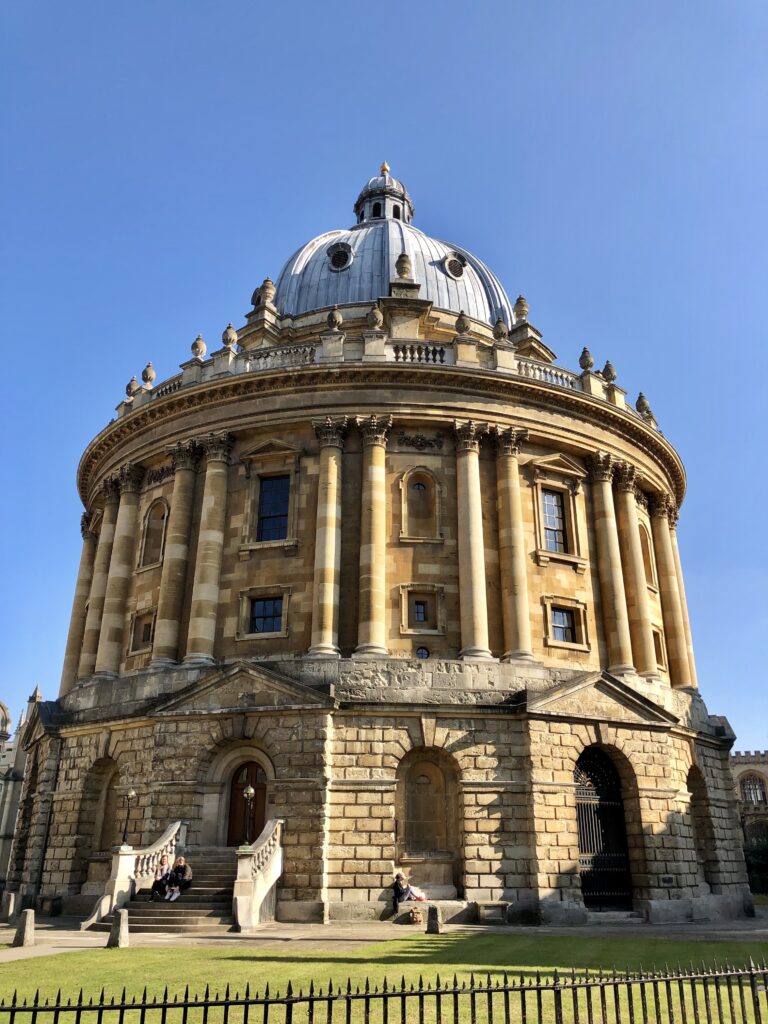
STUNNING ARCHITECTURE
Oxford is renowned for its stunning architecture, including the grand Gothic buildings of the University of Oxford, the beautiful 18th-century Radcliffe Camera, and the medieval Carfax Tower. Visitors can take a stroll through the city’s winding streets and admire the beautiful buildings, including the many churches, museums and libraries.
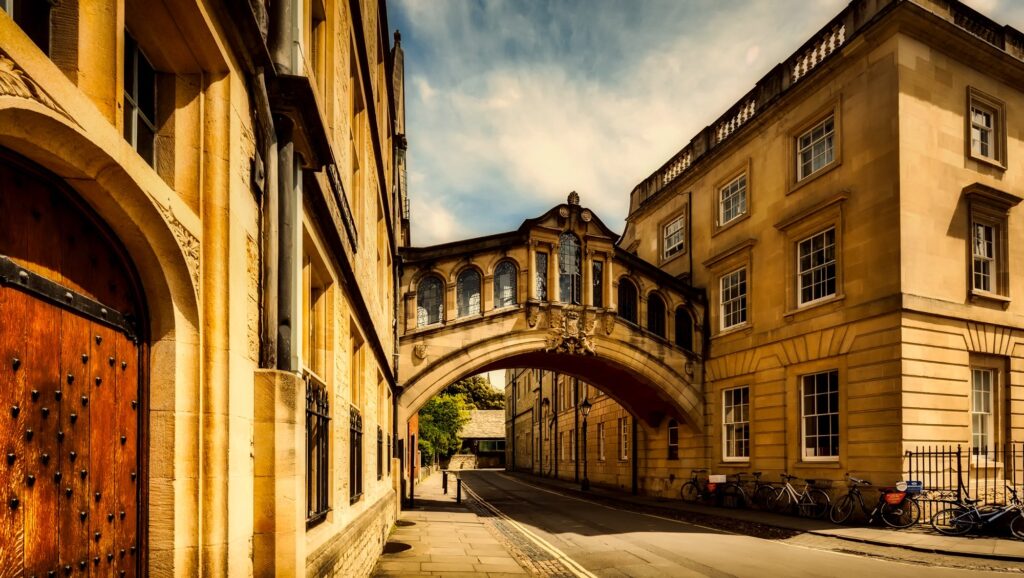
RICH CULTURAL SCENE
Oxford is home to a thriving cultural scene, with numerous museums, galleries, and cultural institutions offering a wealth of exhibitions, performances and events. Visitors can explore the Ashmolean Museum, which houses one of the finest collections of art and archaeology in the world, or attend a performance at the Oxford Playhouse, one of the country’s leading theatres.
WORLD-RENOWNED HISTORY
Oxford has a rich history, dating back to medieval times, and is home to many historic sites and landmarks, including the beautiful medieval Christ Church College, the famous Radcliffe Camera, and the iconic Carfax Tower. Visitors can explore the city’s many museums and galleries, which offer a fascinating insight into its rich past, or take a guided walking tour to learn more about Oxford’s history and heritage.
EXCELLENT SHOPPING
Oxford is a shopper’s paradise, with a wide range of shopping options, from high-end boutiques and designer shops to quaint, independent stores selling unique gifts and souvenirs. Whether you’re looking for the latest fashion, unique antiques, or handcrafted goods, Oxford has something for everyone.
FINE DINING
Oxford is home to a thriving food and drink scene, with many local restaurants, cafes and bars offering a range of dining experiences, from casual pub meals to gourmet dining. Whether you’re a foodie, a wine connoisseur, or simply enjoy trying new things, Oxford has something to suit every taste and budget.
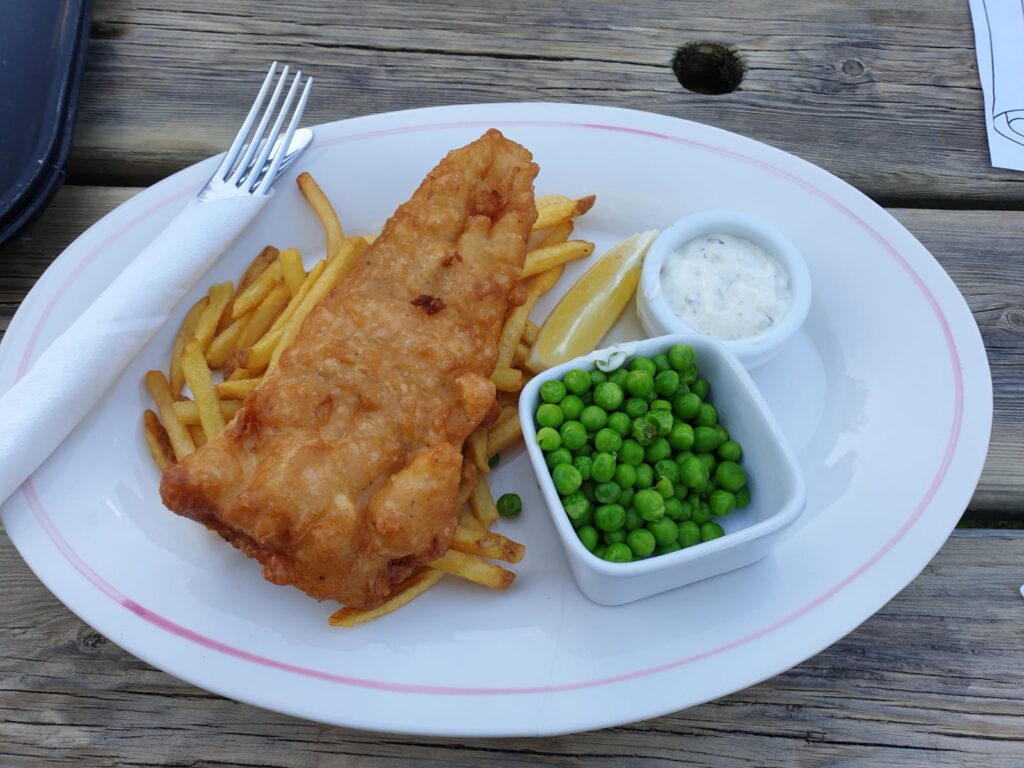
Outdoor Activities
Oxford is surrounded by beautiful countryside, offering a range of outdoor activities, from scenic walks and cycle rides to water sports and horse riding. Whether you’re an avid adventurer or simply looking to get some fresh air, Oxford is the perfect place to enjoy the great outdoors.
Accommodation
Oxford is home to a range of accommodation options, from charming bed and breakfasts to luxurious hotels. Whether you’re looking for a peaceful escape from the hustle and bustle of city life or a romantic getaway, Oxford has something to suit every taste and budget.
In conclusion, Oxford is a city of contrasts, offering a wealth of history, culture, and beauty to visitors. Whether you’re interested in education, architecture, shopping, dining or outdoor activities, Oxford has something for everyone. With its rich history, stunning architecture, vibrant cultural scene, and world-class facilities, Oxford is a must-visit destination for anyone looking for a truly memorable experience.
8 Reasons Why You Should Visit The Cotswolds.
The Cotswolds is a picturesque area located in the south of England, stretching across six counties and encompassing several charming towns and villages. This area is known for its rolling hills, traditional stone houses and idyllic countryside, making it the perfect destination for a peaceful and relaxing getaway. Here are some reasons why you should visit the Cotswolds.
Scenic Beauty
The Cotswolds is a breathtaking region of natural beauty, dotted with charming villages and quaint towns. The rolling hills and sprawling countryside provide the perfect backdrop for scenic walks, horse rides and bike rides, and offer breathtaking views that are truly unmatched. Whether you’re an avid hiker or simply looking to take in the scenery, the Cotswolds is the ideal place for you.
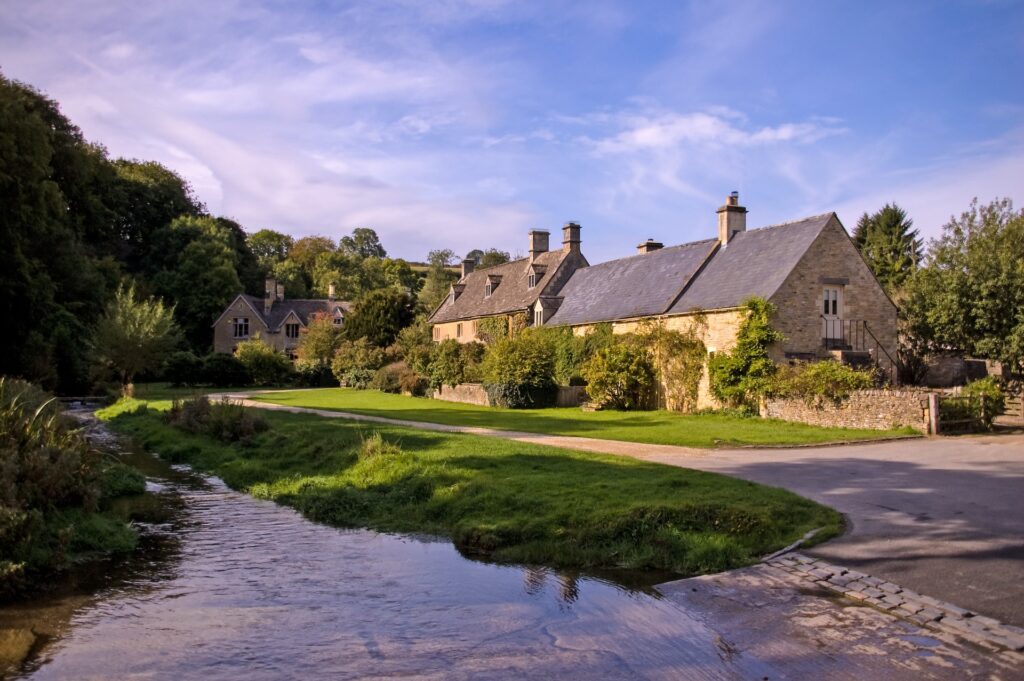
Rich History
The Cotswolds has a rich history, dating back to the medieval times. The area is steeped in history, and its heritage is evident in the many historic buildings, monuments and attractions that are still standing today. Visitors can explore the ancient ruins of Cirencester, the charming medieval town of Burford and the Roman spa town of Bath, to learn more about the region’s rich past.
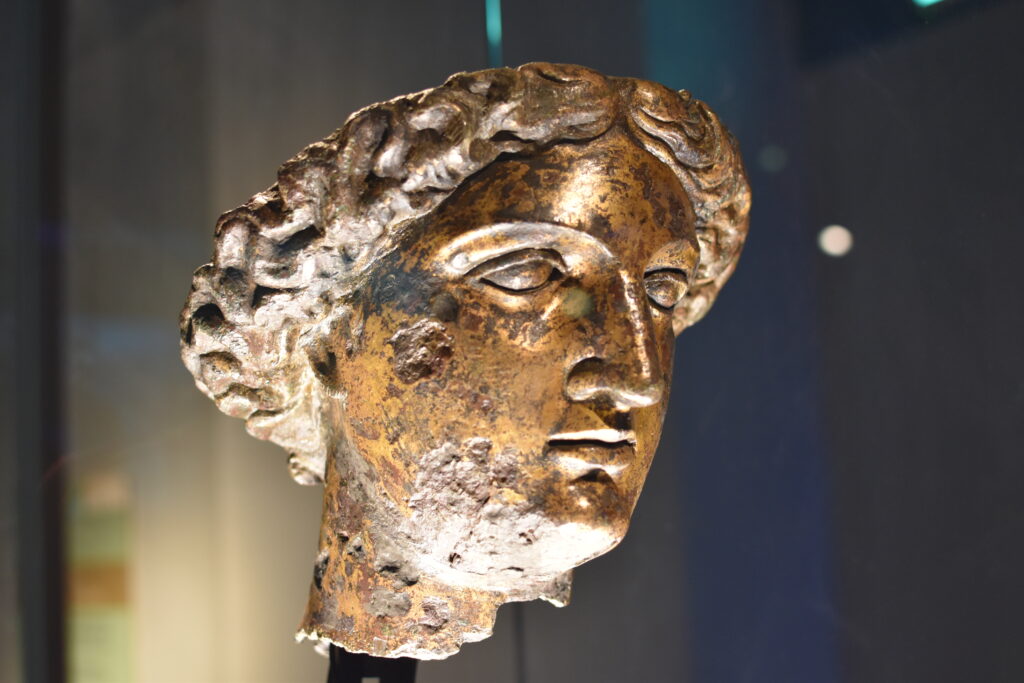
Warm and Welcoming Communities
The people of the Cotswolds are incredibly friendly and welcoming, and are more than happy to share their love of the area with visitors. Whether you’re in the market for a delicious local meal, a cosy bed and breakfast or a relaxing drink, the Cotswolds has something to offer everyone.
Cultural Attractions
The Cotswolds is home to many fascinating cultural attractions, including historic houses, museums, galleries and more. Visitors can explore the iconic Westonbirt Arboretum, the famous Shakespeare birthplace and the world-renowned Tate Modern gallery, to experience the region’s rich cultural heritage.
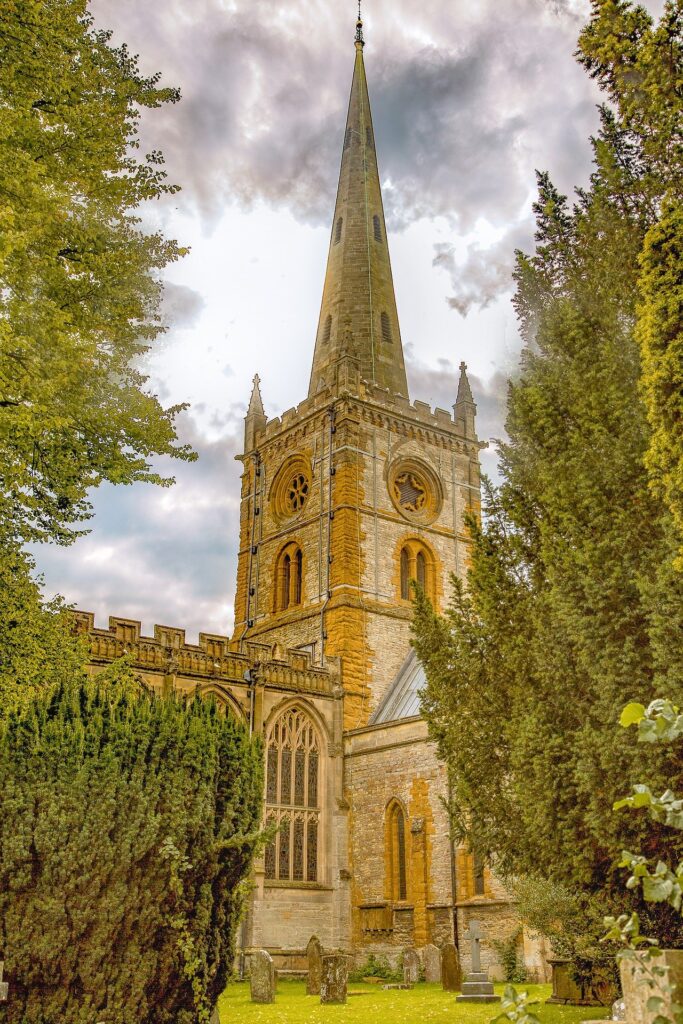
Outdoor Activities
The Cotswolds is an outdoor enthusiast’s paradise, offering a range of activities to suit everyone, from the more strenuous pursuits such as hiking, cycling and horse riding to more leisurely pastimes like fishing, bird watching and picnicking. Whether you’re an experienced adventurer or simply looking to get some fresh air, the Cotswolds has something to offer you.
Local Cuisine
The Cotswolds is home to a thriving food and drink scene, with local producers and suppliers offering some of the finest produce in the country. Whether you’re a foodie, a wine connoisseur or simply enjoy trying new things, the Cotswolds has something for you. From traditional pubs serving local ales and ciders to gourmet restaurants offering the finest dining experiences, you’ll be spoilt for choice.
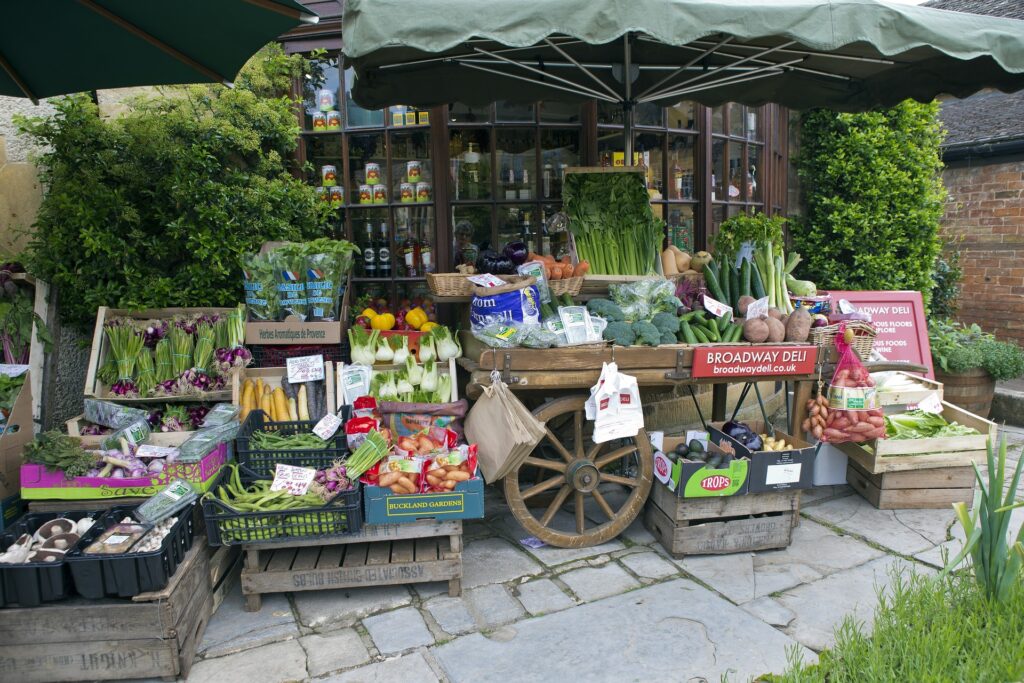
Accommodation
The Cotswolds is home to a range of accommodation options, from charming bed and breakfasts to luxurious country hotels. Whether you’re looking for a peaceful escape from the hustle and bustle of city life or a romantic getaway, the Cotswolds has something to suit every taste and budget.
Shopping
The Cotswolds is home to a wealth of shopping opportunities, from quaint country markets selling local produce to high-end boutiques and designer shops. Whether you’re looking for unique gifts and souvenirs, handcrafted goods or the latest fashions, the Cotswolds has something for everyone.
In conclusion, the Cotswolds is the perfect destination for a relaxing and rejuvenating getaway. Whether you’re looking for scenic beauty, rich history, friendly communities, cultural attractions, outdoor activities, local cuisine, accommodation, or shopping it’s easy to see why the Cotswolds are such a sought after place to visit!
Want to take a tour of the Cotswolds? Why not take a look at our:
Private Explore the Cotswolds Tour from London
Private Day In The Cotswolds Tour
Private Downton Abbey Day In The Cotswolds Tour
Our Top Places To Vist In Wales
Want to vist Wales but aren’t sure where you should visit? Why not take a look at the 10 places that our Welsh guides have recommended? Listed in no particular order, you could follow the list from North to South Wales and explore the whole country if you wanted to!
The Snowdonia National Park
This beautiful park in north Wales is home to Snowdon, the highest mountain in Wales. It’s a popular spot for hiking, rock climbing, and other outdoor activities. The Snowdonia National Park is also home to some rare and endangered species such as Red Squirrels and Pine Martens, these rare animals, and the abundance of birds make the Snowdonia National Park a perfect place to visit if you happen to love animals. One of the best ways to see the national park, and the nature that it has to offer, is on one of the many scenic railways. Not only can you get the train up to the summit of Snowdon (known in Welsh as Y Wyddfa and is pronounced as “er with-va”) but you can also explore the beautiful countryside of North Wales by taking a trip on one of the many steam trains. Why not take the Ffestiniog and Welsh Highland Railway from the famous Norman fort of Caernarfon, through the mythical town of Beddgelert, and down to the wettest town in Wales Blaenau Ffestiniog
Conwy
Conwy is a small walled town located on the north coast of Wales. It is a popular destination for tourists due to its rich history, stunning architecture, and scenic location. Visitors can explore Conwy Castle, a UNESCO World Heritage Site, which was built in the 13th century and offers stunning views of the town and surrounding countryside. The town is also home to several other historic buildings, including the medieval walls and gates, the smallest house in Britain, and Plas Mawr, a beautifully preserved Elizabethan townhouse. Conwy is located on the shores of the Conwy estuary, which offers stunning views and a range of activities from Water sports to birdwatching. The town is also a great base for exploring the nearby Snowdonia National Park, which is renowned for its stunning scenery and outdoor activities. With its rich history, beautiful architecture, and stunning natural surroundings.
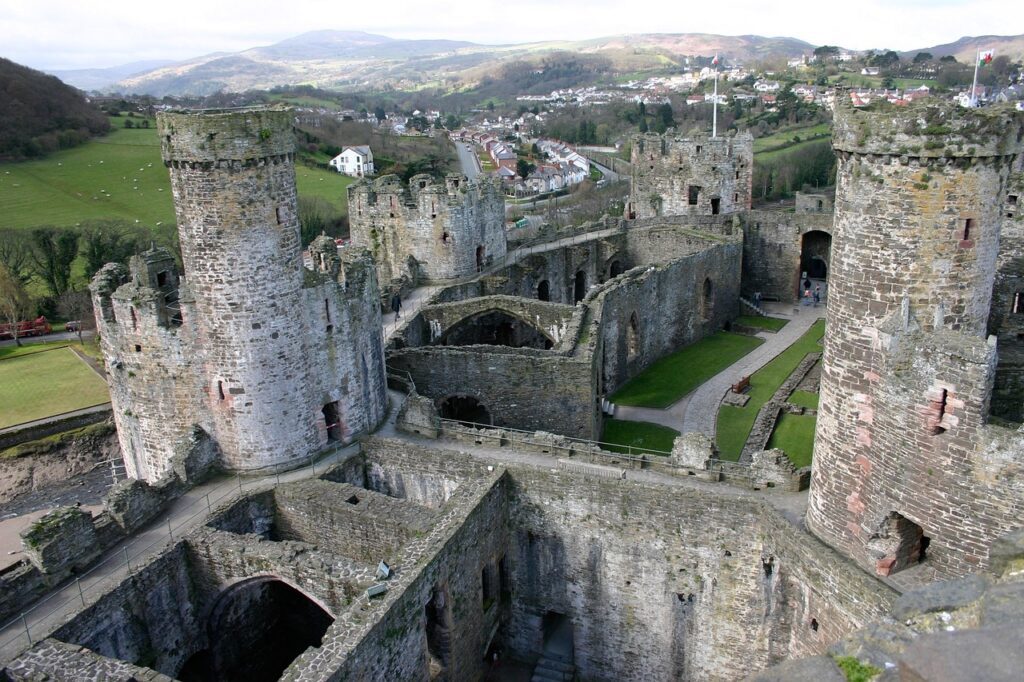
Llandudno
Llandudno is a popular seaside resort town located on the north coast of Wales, at the foot of the Great Orme headland. It is known for its beautiful sandy beaches, Victorian architecture, and scenic location. Visitors can take a ride on the Great Orme Tramway, a cable-hauled tramway that takes passengers to the top of the Great Orme headland, which offers stunning views of the town and surrounding countryside. Llandudno is also home to several historic buildings, including the 19th-century pier, the neo-gothic St. Tudno’s Church, and the Llandudno Museum, which houses artifacts and exhibits relating to the town’s history. The town’s shopping district, Mostyn Street, offers a range of independent and high-street shops, as well as several cafes and restaurants serving locally sourced produce. Close to the island of Anglesey, the city of Bangor, and the UNESCO World Heritage Site of Caernarfon, Llandudno is the perfect place to stay, if you fancy exploring the north Wales countryside and coastline by car.
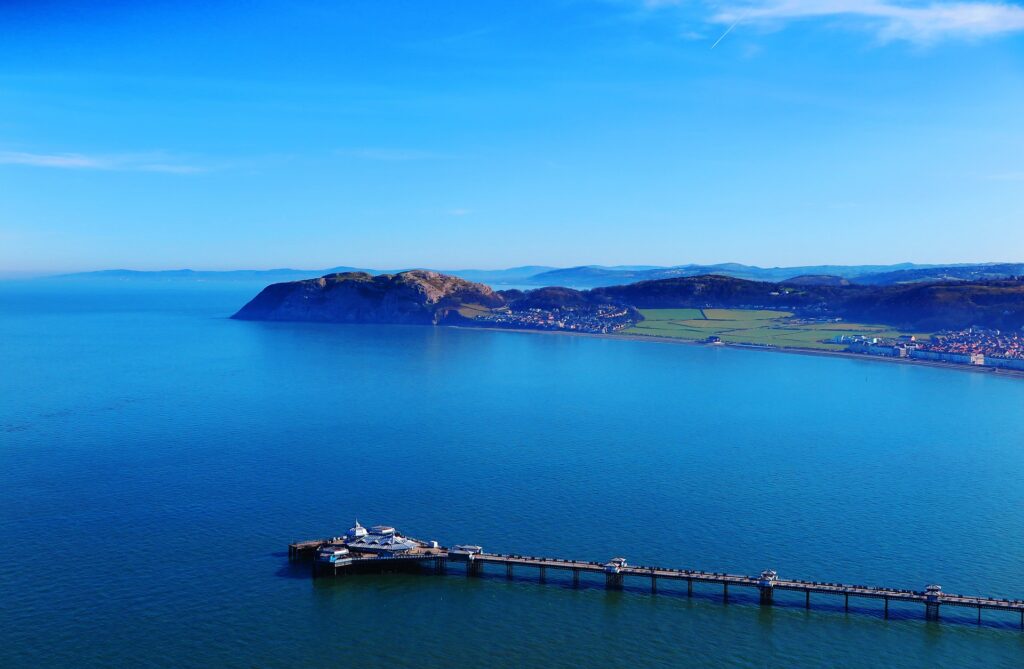
Aberystwyth
Aberystwyth is a charming seaside town located on the west coast of Wales, known for its stunning scenery, rich history, and vibrant cultural scene. Once suggested to be the capital of Wales, thanks to institutions such as Aberystwyth University and the National Library of Wales, Aberystwyth could be seen as the Welsh Oxford. Founded in the 13th-century with the building of Aberystwyth Castle, which sits on a hill overlooking the town today Aberystwyth is also known for historical buildings such as the University’s Old College which was built in the style of the Gothic revival, its 1920’s Train Station, and its range of old, traditional pubs. Aberystwyth is also home to several museums and galleries, including the Ceredigion Museum, which tells the story of the region’s history and culture, and the Aberystwyth Arts Centre, which showcases a range of exhibitions, performances, and events. The nearby Ynyslas National Nature Reserve is home to a range of wildlife, including rare birds and seals, and the Aberystwyth Cliff Railway provides easy access to the famous Constitution Hill. The Rheidol Railway also has a terminal in the town. This small railway (which was once used to transport Lead to Aberystwyth Harbour) takes travellers up the Rheidol Valley on a scenic steam train ride through the picturesque countryside. Our advice is take an early train, sit in the last carriage and enjoy the view as you travel to Devil’s Bridge. Once there explore the waterfalls, learn the myths and the legends of the Devil’s Bridge and take an afternoon train back to Aberystwyth and once again sit in the last carriage as you get some exceptional views of the train snaking round the mountains!
Pembrokeshire Coast National Park
This beautiful coastal park in west Wales is home to some of the most breathtaking beaches in the country, as well as a number of charming towns and villages including Tenby and St David’s. The Pembrokeshire town of Fishguard was the last place in mainland Britain to be invaded back in 1797 when the French invaded, only to be stopped by the local Welsh women! If you like to walk, the coastal path, which runs around the whole of Wales making it the only country in the world where you can walk the whole length of the country’s coast, offers some exceptional views. You may even see a Dolphin or two if you’re lucky!
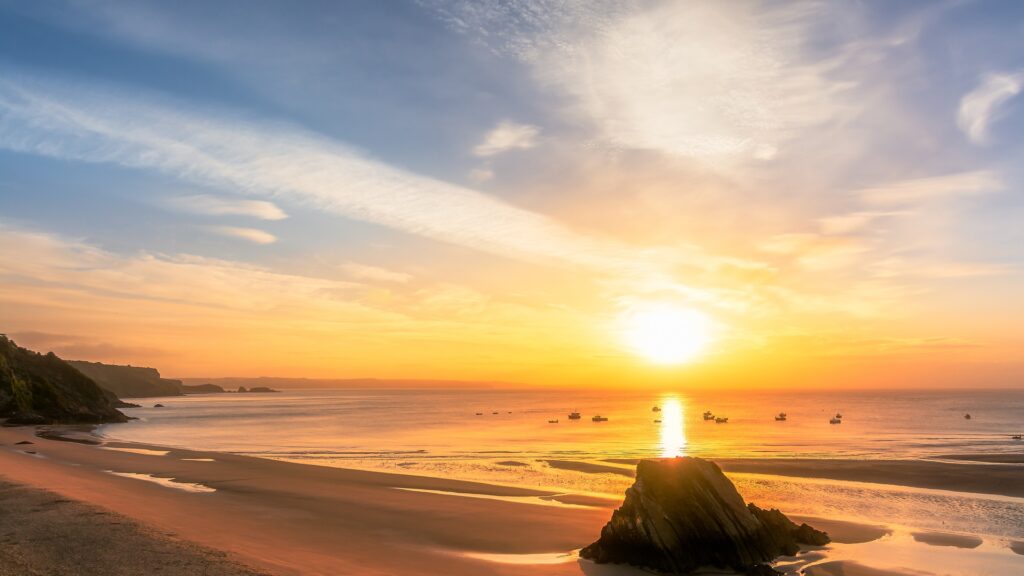
Tenby
Tenby is a charming coastal town located in the Pembrokeshire Coast National Park in West Wales. It is a popular destination for tourists due to its stunning scenery, sandy beaches, and picturesque harbour. The town is famous for its pastel-coloured Georgian houses, which line the narrow streets of the old town. Visitors can explore the historic town walls, which date back to the 13th century, and the ruins of Tenby Castle, which offer stunning views of the town and surrounding coastline. Tenby is also a great destination for water sports enthusiasts, with a range of activities on offer, including surfing, kayaking, and paddleboarding. The town has a thriving arts scene, with several galleries and art shops, and hosts the annual Tenby Arts Festival. With its relaxed, friendly atmosphere, beautiful scenery, and rich history, Tenby is a must-visit destination for anyone traveling to Wales.
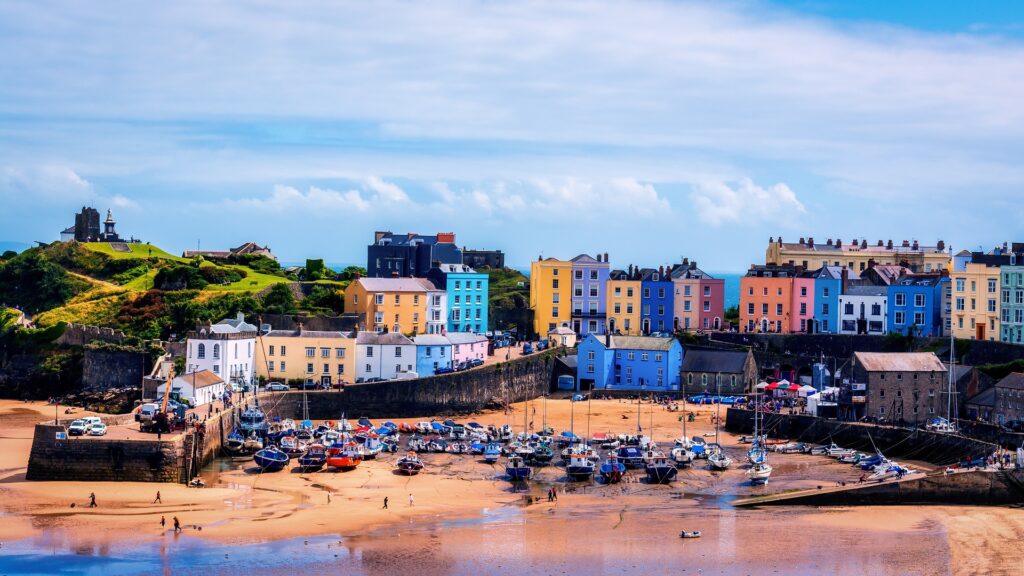
St David’s
St David’s is a small city located on the far western coast of Wales, in Pembrokeshire County. It is named after the patron saint of Wales, Saint David, and is the smallest city in the UK. Despite its size, St David’s is a popular destination for tourists due to its beautiful architecture, rich history, and stunning natural surroundings. Visitors can explore the 12th-century St David’s Cathedral, which contains the shrine of Saint David, as well as several other historic buildings, including the medieval Bishop’s Palace and St Non’s Chapel, which is said to be the birthplace of Saint David. The city is located in the heart of the Pembrokeshire Coast National Park and is surrounded by some of the most breath taking scenery in the UK, including rugged cliffs, sandy beaches, and hidden coves.
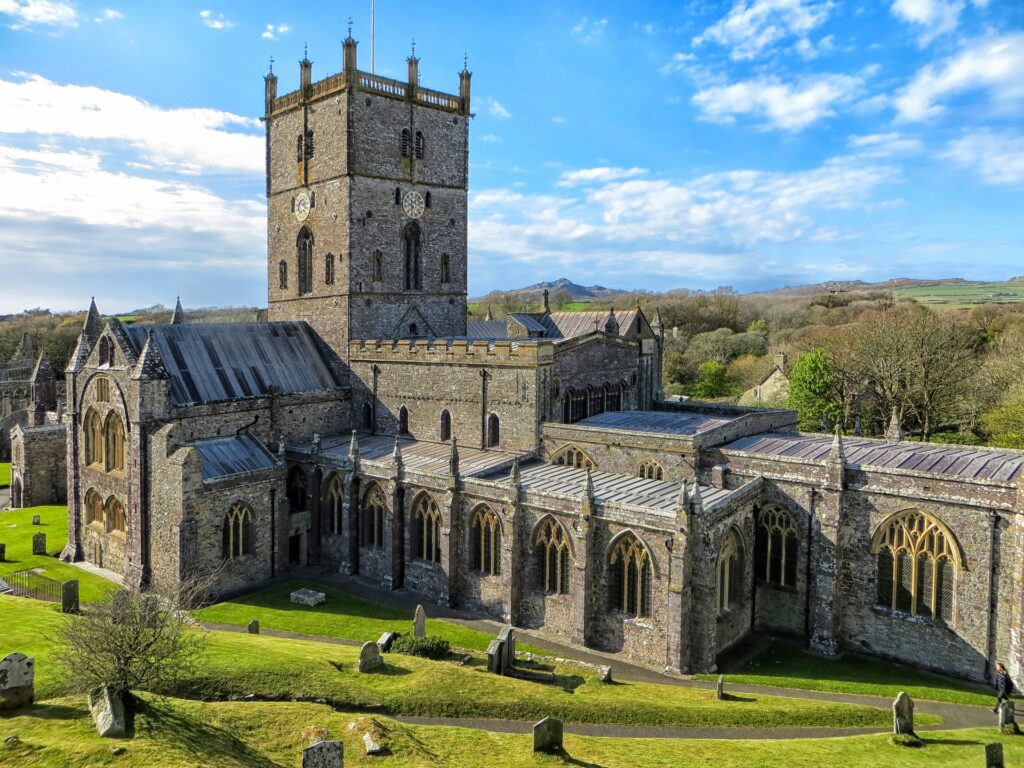
The Brecon Beacons National Park
This national park in south Wales is home to some of the most stunning landscapes in the country, including waterfalls, mountains, and valleys. It’s also a great place for outdoor activities such as hiking, biking, and horse riding. Famous for being the training centre for the British Army (the Infantry Training Centre is nearby in the town of Brecon, and the British Special Air Service also train in the area) some of its paths and walks are not for the fait hearted. That said the views from Pen Y Fan, the tallest mountain in South Wales can reach, on a clear day, all the way to Bristol! Take your time and a packed lunch, and you won’t be disappointed by the views.
Hay-on-Wye
Hay-on-Wye is a small market town located on the Welsh-English border that has gained worldwide recognition for its vast collection of bookshops. It is home to over 20 bookshops, making it a haven for book lovers worldwide. The town also hosts the Hay Festival of Literature and Arts, a world-renowned cultural event that attracts famous authors, artists, and musicians. This festival has been running for over 30 years and has helped to cement Hay-on-Wye’s reputation as a cultural hub. Additionally, the town’s stunning location, surrounded by the Black Mountains and the River Wye, adds to its allure, making it a popular tourist destination for those seeking to explore the beauty of the Welsh countryside. Even if you don’t love books the town is still worth a visit as its cosy cafés, restaurants selling local produce, and pubs make it an excellent place to stop whilst exploring Wales.

Cardiff
Wales’ capital city is a vibrant and cosmopolitan place with plenty of cultural attractions, including the Wales Millennium Centre, Cardiff Castle, and the National Museum Cardiff. A Vibrant city with a rich cultural scene, we highly recommend the National Museum Cardiff which houses an enviable collection of impressionist and post-impressionist art by artists such as Monet, Van Gogh, and Renoir. Looking for somewhere to eat in Cardiff? Why not try Y Dosbarth/The Classroom? This restaurant is a hidden gem and is part of the local college which the food critic Jay Rayner described as ‘really excellent’. Serving Modern European Food, it is really not to be missed… even if the entrance (which is the main entrance to the college) may be difficult to find.
From Cardiff you could explore some of the old Norman castles which the area is known for. If you wanted to take the easy option you could always book our Private Day Tour of Cardiff, including Cardiff Castle and Caerphilly Castle. Or if you wanted to take a trip back in time why not visit the 2019 Museum of the year on our Private Day Tour of Cardiff, including Cardiff Castle, St Fagan’s and Cardiff Bay which visits the famous St Fagan’s Museum where numerous ancient buildings from across Wales have been lovingly restored.
Did you know that the hit BBC TV series Doctor Who has been filmed in Wales since 2004? Cardiff has been a big part of Doctor Who, but so have many of the other locations we’ve listed here. Want to learn more about the filming of Doctor Who in Cardiff? Why not check out our Doctor Who tours on our tours page?
10 Facts About James Bond You Probably Didn’t Know
We are approaching the 70th anniversary of James Bond as a character in literature. The first James Bond novel, Casino Royale, was published on the 13th of April 1953.
Here are ten facts you may not know about James Bond and his world from the novels and films.
1-James Bond’s Drug Use
Bond’s enjoyment of cigarettes and alcohol is well known, but in the novels, he also uses Benzedrine, which is an amphetamine. Benzedrine was used in inhalers from the 1930s, and in World War 2, it was used to combat fatigue in soldiers, and this is why Bond uses it in the novels. In a number of instances, the drug gives Bond the edge he needs to win.
Bond takes tablets before his final mission in Live and Let Die. He uses the drug to keep sharp during his arduous underwater swim through the coral reef to the island of Surprise.
In the next novel Moonraker, Bond is asked by M to prove that Hugo Drax is cheating at cards. Before the high-stakes bridge game where Bond intends to teach Drax a lesson, he has dinner with M. An envelope is delivered to him which contains Benzedrine and in front of M, Bond mixes Benzedrine with Dom Perignon champagne. As M says, “It’s your funeral.”
Bond also takes Benzedrine in The Spy Who Loved Me. This time with coffee.
The only reference in the films to Bond taking anything other than alcohol is in Skyfall when Silva is looking at Bond’s medical report and reads aloud, “Alcohol and substance abuse indicated”.
2-Bond’s Address
In the novels, Bond’s address is never given, but it’s revealed that he lives in a ground-floor flat in a square off the King’s Road in Chelsea. Bond’s flat is provided by the government, and Bond has an elderly Scottish housekeeper called May Maxwell. May only appears in the novels.
In the films, Bond’s flat has been seen three times, in Dr No, Live and Let Die and Spectre. A number of props from the films feature Bond’s onscreen address, which is 61 Horseferry Road. Horseferry Road is real, but there is no number 61 in real life.
3-The Epidemiological Analysis
A couple of years ago, an amusing paper written by Wouter Graumans, Teun Bousema and Will Stone was published in the journal Travel Medicine and Infectious Disease. The paper covered James Bond’s risk of infections during his travels. The three academics watched all the Eon James Bond films as research. They counted 86 international journeys to 47 countries. In the paper, they go through all the risks in the various locales that Bond encounters, and it’s very entertaining. If you want to read the paper in full you can do so HERE.
4-Before Vauxhall Cross
The SIS (Secret Intelligence Service) moved into their current building at 85 Albert Embankment in 1994. And it was from that point that the public was finally aware of where the British Secret Service headquarters were located, and as it is such a distinct structure, it made sense to include the building in the James Bond films. Before 1994 the locations of the secret service were secret.
Ian Fleming, the creator of James Bond, chose to put his version of the secret service in an office block overlooking Regent’s Park. At the time Fleming was writing his novels, and during the release of the first two Bond films, the SIS was based at 54 Broadway. Then in 1964, they moved to Century House at 100 Westminster Bridge Road, where they were until 1994. It’s hard to imagine Bond or M in this building. In a government report in 1985, it was called “irredeemably insecure” as it was made mostly of glass and had a petrol station at its base. The Daily Telegraph once said that it was “London’s worst-kept secret, known only to every taxi driver, tourist guide and KGB agent”.
5-Bond’s Closest Ally
The character of Bill Tanner is M’s chief of staff and has been played by four actors over eight films. Michael Goodliffe (uncredited) in The Man with the Golden Gun, James Villiers in For Your Eyes Only, Michael Kitchen in Goldeneye and The World Is Not Enough and Rory Kinnear since Quantum of Solace. In the novels, Tanner is a minor character, but unlike in the films, Bond and Tanner are very close. They are friends, often play golf together, and Tanner is Bond’s closest ally in the British secret service. This friendship has never been explored in the films.
6-Moonraker
For fans of the Bond films who want to read the original novels, I would recommend reading them in order starting with Casino Royale. It’s hard to choose a favourite Bond novel, but I love Moonraker, which was the third Bond novel published in 1955. It bears no relation to the 1979 film apart from the name Hugo Drax. It’s the only novel where Bond stays in Britain, and in my view, it’s a blueprint for modern blockbusters. The stakes are raised much higher than in the previous two stories as Bond has to stop the destruction of London with a nuclear weapon. The book also reveals details about Bond’s life when he is not on a mission. The subject matter was heavily researched by Ian Fleming, and it shows. The book was way ahead of its time and in my view could possibly be the first techno-thriller. It’s also a book of its time and plays very strongly on the fears of the 1950’s as it’s about nuclear destruction, attack from above by rockets (the V2 attacks had been 10 years before), communism and the re-emergence of Nazism. And if you think that Bond always gets the girl, well…you will have to read the book. A year after publication there was a BBC radio adaptation of Moonraker broadcast in South Africa. It starred Bob Holness as James Bond. Holness is best remembered these days as the host of the popular quiz show (from the 80′ and 90’s) Blockbuster. Holness wasn’t the first actor to play Bond…
7-Barry Nelson and Casino Royale
The first actor to play James Bond was Barry Nelson in a 1954 television adaptation of Casino Royale. Nelson was a successful and popular character actor in his day and these days is best known for playing Stuart Ullman, the manager of The Overlook Hotel in Stanley Kubrick’s film of The Shining. The television Casino Royale was the third episode of a new American anthology television show called Climax. It was broadcast in the USA on October the 21st 1954. Ian Fleming was paid $1000 for the rights. As James Bond was not yet the well-known character he would become quite a number of liberties were taken with the story. In the episode James Bond is American, Vesper Lynd and Rene Mathis are combined into one character called Valerie Mathis, and Felix Leiter is changed to Clarence Leiter and is working for British Intelligence. The episode is worth watching as a curious period piece and also because Le Chiffre is played by legendary actor Peter Lorre who is the best actor in it. The episode can be watched for free on YouTube.
8- Daddy Bond
In No Time To Die it’s revealed that Bond is a father. But Bond actually fathers a child in the original novels. At the end of the novel of You Only Live Twice, Bond loses his memory and conceives a child with Kissy Suzuki. Bond leaves before Suzuki has a chance to tell him that she is pregnant with his child. Whether Fleming would have explored the fate of this child in future novels, we will never know as Fleming died shortly after publication. The fate of the child was explored in a short story by Rayond Benson called Blast From The Past. In this story Bond has a son from Kissy called…you guessed it, James.
9-Scrambled Eggs’ James Bond’
The recipe for Scrambled Eggs’ James Bond’ is revealed in a short story called 007 In New York. Ian Fleming loved scrambled eggs and it’s his own recipe. It’s not known how often Bond eats this as it involves twelve eggs although the recipe does serve four people. Fleming insists that it is served “on hot buttered toast on individual copper dishes (for appearance only) with pink champagne (Taittinger) and low music.”
10-Coffee Over Tea
James Bond does not like Tea. When he is not drinking alcohol, he drinks coffee. In the novel Goldfinger, Bond says, “I don’t drink Tea. I hate it. It’s mud. Moreover it’s one of the main reasons for the downfall of the British Empire.” In the novel Thunderball, Fleming says of Bond, “Bond loathed and despised tea, that flat, soft, time-wasting opium of the masses.” Bond’s taste usually reflected those of his creator Ian Fleming. Bond drinks coffee a number of times in the books and films. Bond drinks coffee from an American filter machine called a Chemex. In the ’50s, this was the height of sophistication, and most people in Britain had never heard of it and definitely would not own a coffee machine. This shows how much Bond favours coffee over Tea.
Want to know more about James Bond? Why not book our James Bond Walking Tour of London?
